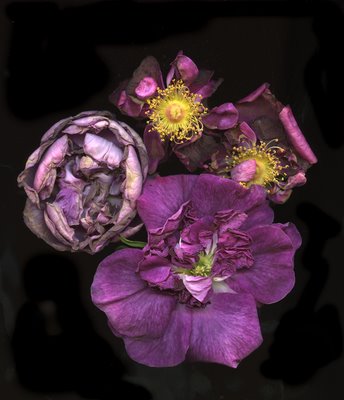
My favourite writing pathologist, F. Gonazález-Crussi begins in The Flowers of Evil in the Garden of Biology , a chapter from his 2004 book of essays On Being Born:
Consider a man's beginnings. Before his father adn mother are joined in sexual embrace, he is nothing: he does not exist. He has never been, throughout the eterniy prior to that moment. Never. But this thought, that a whole infinity had to pass before he was rescued from naught, scarcely troubles him. What he is aprehensive about, if not terrified, is death. Most of us are to a certain extent. Presumably, our fear arises from the awareness that we are to return to the nothingness whence we came. What troubles us is the going there, not the coming therefrom.
Why would it be that non-existence weighs more upon our hearts when regarded as future, than when evoked as past? It can only be because life is unidirectional, and we, who are immersed in its current, feel for what lies ahead only, not for what is left behind. We are creatures of the vital flow, which runs forward without pause, remitment, or reversal. Were it not so, we would feel appeased by considering the two immensities as equivalent: the infinite time that ran its course before my birth, and the eternity that shall flow after my death.
Sad consolation: try to soothe ourselves of the infinite time after death, with the thought of the infinite time before birth!
And yet, theoretically, we must admit that the equivalent is perfect. As Schopenhauer pompously put it, "the infinity a parte post without me cannot be any more feerful than the infinity a parte ante without me," the reason being that the two infinities are absolutely identical. If they seem distinct, he said, it is only because of the interposition of "an ephimeral life dream."
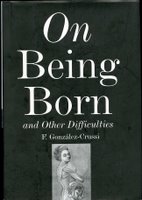
The above words hung heavy in my mind in a conversation yesterday afternoon when the fine hot day had become a cool and more pleasant one in a garden where the smell of roses wafted from all directions. Two men were talking to each other in my presence. One of them, a younger man had been at death's door and by a miracle of medicine he was alive with a future in front of him. The other talked of his long past and how he was making preparations to get rid of material posessions because of the inevitability of a soon to come death. The latter even told us of having cradled in his arms a dying artist. "His death was not a pretty sight," he added.
After they left I noticed how many of my pristine roses, which had given my garden visitors and I so much pleasure during the day, had faded. Petals were falling as death was setting in.
Here you see three gentlemen who have left no trace in history except their name on a rose. Below right is the gallica rose Charles de Mills. Above and right are two Alain Blanchards also gallicas. Top left is a fading moss rose, Rosa 'William Lobb'.
The three gentlemen are fading. The originals are long gone and forgotten. They live on as roses that fade, and die too. To me these three gentlemen are maidens. Roses are all women. I would say of my modern gallica Rosa 'James Mason', "She is a lovely rose."
As for the two gentleman visitors to my garden I can only hope that they both live long and prosper.
The Naked Rosarian
Sunday, June 29, 2008
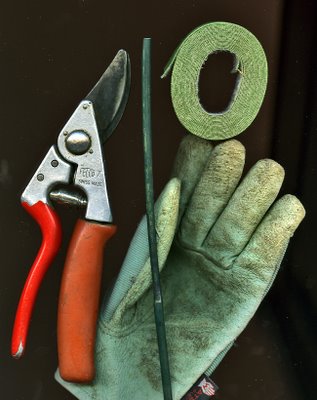
Today Rosemary and I have opened our garden for the Vancouver Rose Society. Lauren will be holding court from 1:30 on (she had to go to a birthday party) and we will miss Rebecca who is with her other grandmother in Toronto visiting her aunt.
When I go to the garden I feel naked unless I have my Felco (Swiss) secateurs (rose clippers) in my back pocket. It helps when I also have the new-fangled green Velcro tape, a glove for my left hand (with which I hold a thorny rose cane) and some green bamboo stakes with which I prop up the rose branches that might flop because of wind or heavy flowers. Since we rose enthusiasts are called rosarians I would say that I am a naked rosarian unless I have that Felco in my back pocket.
Vancouver Rose Society
Lauren Stewart's Sixth Birthday & Peter Bingham's Knots
Saturday, June 28, 2008
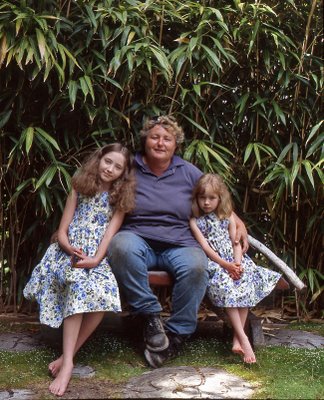
Lauren Elizabeth Stewart was 6 yesterday. I had her all to myself in the evening because Rosemary did not want to accompany us to see Peter Bingham at EDAM to see The Echo Case. What we saw was avant garde and the original improvised music that accompanied the performance was funny, challenging and entertaining. The three men (all bald or with shaved heads)Peter Bingham, Marc Boivin and Andrew Harwood danced in convoluted moves that brought to mind my reading of R.D. Lang's Knots in the early 70s.
Lauren nursed a Ginger Ale through the one-hour-long performance. She laughed, giggled and looked at me to reinforce the fact she thought it all so funny. As soon as it was over she said, "Hold my hand and let's go to the Japanese Restaurant." After performances at EDAM and particularly when Rebecca is around we go to Kishu Island on Main (almost corner with Broadway).
Lauren did not want to drink her green tea, "I don't like green tea." So I told her, "Just like I tell you to imagine that a rose might smell of synthetic apricot jam (Rosa 'Westerland') before you smell it try and think of celery soup. You like celery." There must be something of the flexibility of 6 year old's mind that she then happily drank her tea.
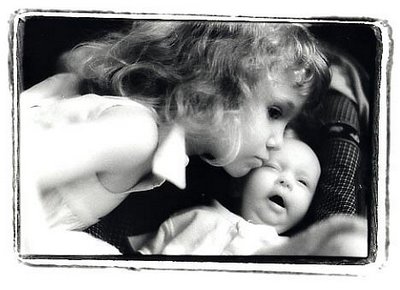
When I was taking her home I was thinking how it was possible that The Echo Case (an extreme example of contact improvisational dance) was absorbed instantly by Lauren without the need that we adults have of figuring what it all means or is supposed to say.
We both had an excellent afternoon and I counted my blessings in being in close geographically to both my granddaughters. I have yet to forget the wonderful time we all four (with Rosemary) had last week at Pacific Shores Resort & Spa in Parksville. Here is a photograph of the two girls with head gardener Michele Keddy (in the Japanese meditation garden) who was warm and knowledgeable and the two girls instantly loved her. Rebecca never questioned Keddy's ability to point her to places where she could find snakes even though she (Keddy) is so afraid of them. Keddy would jump back every time Rebecca picked one up while Lauren stood her ground but was unwilling to get any closer.
Happy birthday Lauren Elizabeth Stewart
Rosa ' Yellow Dagmar Hastrup'
Friday, June 27, 2008
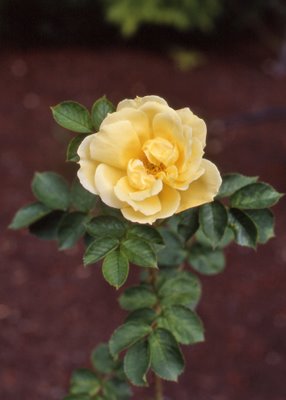
Last week when Rosemary, Lauren, Rebecca and I were at the Pacific Shores Resort & Spa I was pleasantly surprised not only to find a very good and varied garden of good shrubs, trees and perennials but also many interesting roses. One attracted my attention with a nagging suspicion in my mind that I could not peg down. It was a yellow rugosa with a peppery scent. Yellow rugosas are a rare breed. I wrote about rugosas here. The plant in the resort had those narrowish leaves with rugose indentations. But it wasn't Rosa 'Agnes' because the mysterly plant had fewer petals. Agnes was the first yellow rugosa and Canadian, too! There aren't many others. What was it?
Then a few days ago I remembered. Instead of telling you about it look here. Tim Bray has his way with words and besides he is a snob of good draught beer. At this time of the year that makes him real smart!
A Black Ghost In Shaughnessy
Thursday, June 26, 2008
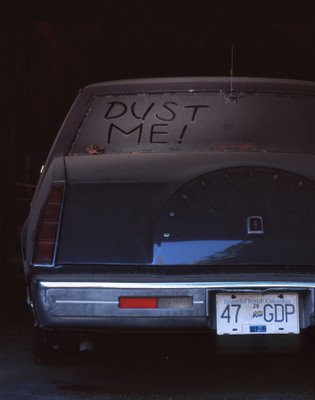
I have what you could call the overdue library book syndrome. I know my book is overdue so I put it into a drawer and close it. With the overdue book out of my site the problem of having to return it does not exist. The problem of course exists as soon as I get that big bill for $20.
I know a man who used to live in Victoria who had a variant of this problem. His name is Mike Gluss and he is a photographer. He was teaching at University of Victoria some years ago and he would get parking tickets. There were few parking spaces and in spite of being a teacher he was not given one. Gluss kept his tickets in a drawer until one day he got a summons and a bill in the thousands of dollars. He made the pages of the Vancouver Sun because of the size of the sum. The last I heard he contested the fines but I never found out if he won. For me the library always gets it book and I pay the fines.
In my garage I have kept out of my sight a 1986 Maserati Biturbo with a transmission clunk. I got tired of spending money on it. At first I though that perhaps some day I would become rich and then I would fix it. It would be my Sunday car. The prospects of getting rich are non existent. My friend Paul Leisz asks me if I have drained the oil, etc. I just don't answer. As long as I don't see it the problem does not exist.
While walking through a Shaughnessy street I think I spotted someone else's library book syndrome. When I saw it I thought of it as a ghost. I don't ever photograph ugly things. I think this Lincoln Continental is beautiful even if it is overdue.
Hydrangea aspera - Sharkskin & Buttered Sandpaper
Wednesday, June 25, 2008

Often when I photograph male lawyers, politicians and businessmen I am asked by their handlers what they should wear. Since we are now firmly esconced in the 21st century the days of taking pictures of energy executives looking into the future are gone. We want to see their eyes. Can we trust them now? Gone are the days of using low camera angles to make them look more powerful or the use of blue backlights to denote high technology. I tell their handlers to clothe them in textured suits with warm fall colours. I tell them to avoid white shirts (they compete too much with their white faces) and suggest blue shirts. I sometimes tell them to stay away from shiny black suits, specially sharkskin suits.
This morning as I made the rounds of the garden I looked at my Hydrangea asperas. I have three kinds, Hyddrangea aspera, Hydrangea aspera 'Villosa' and Hydrangea aspera ssp. sargentina. All three are similar except the straight Hydrangea aspera has narrower leaves. The leaves of the sargentiana tend to get larger after some years. I have seen a specimen in VanDusen whose leaves have rounded out and are 9 by 11 inches. The one here, a leaf from a Hydrangea aspera ssp. sargentiana is 10 inches long.
All three kinds have large lacecap flowers and visitors to my garden always ask, "What is that?" as if they have just spotted a visitor from Mars. I always ask them to touch the leaves and tell them, "It's exactly like sharkskin."
Not too many British know that their fish and chips sometimes is made from the dogfish. A dogfish, (loosely appled to three families Scyliorhinidae, Dalatiidae and Squalidae). Mexicans are less secretive about dogfish or cazó. I often saw them in fish markets. One time I asked the vendor to let me touch one.
Aspera leaves are exactly like sharkskin. I would describe the feel as buttered sandpaper. It is rough but somehow, smoothly rough. I can understand that a fast swimming shark could give a human skin burns by just passing by.
Visitors to my garden, after touching the aspera leaves look at the plant with and almost fearful respect. I love my hydranges but I specially love my asperas. They thrive in all but absolute shade (they need water, though) and they have no pests or diseases.
hydrangeas
More hydrangeas
and more hydrangeas
and even more
and just one more
Lauren Stewart - The Unfurling Of A Child's Personality
Tuesday, June 24, 2008
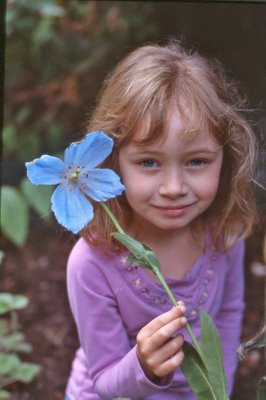
Rebecca has gone to Toronto with her other grandmother for nine days. This means that when we open our garden to the Vancouver Rose Society this Sunday she will not be around to hostess and identify the roses to the visitors. We will miss her.
But there is a positive side to this. We are going to have Lauren with us on Friday, Saturday and Sunday. She is going to have a couple of sleepovers. She will have no competition. On Sunday she will wear her flowered dress and perhaps ID a few roses. It's not important. What is important and has become an exquisite pleasure is to be able to discover the unfurling of her child's personality. Rosemary and I can almost see it, very much like in that pioneering 1953 Disney film The Living Desert where flowers opened like magic.
For about 4 years of her 5 years Lauren has been standoffish. Suddenly she likes to snuggle and show affection. I lap it up. Rosemary and I will miss Rebecca but we will enjoy every moment we have with Lauren.
Here you see Lauren (last Friday) at Pacific Shores Resort & Spa in Parksville with a specimen of Meconopsis betonicifolia, otherwise known as the Himalayan poppy.
Romance On The BC Ferries
Monday, June 23, 2008
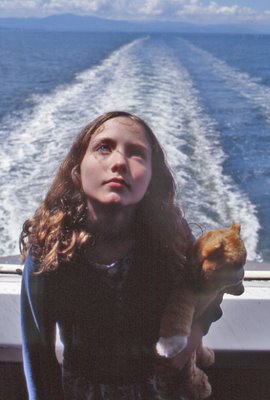
Except for the problems of colissions and sinkings I would think that being a captain of a BC Ferry would be just about the same as captain of a barge. I would not think it to be romantic. Some many years ago writer Ben Metcalf and I went back and forth all day on the Queen of Coquitlam without ever getting off. It would be many years later before I would get off in Nanaimo and visit the town. At the time the Queen of Coquitlam was state of the art and her claims to fame were identical bridges fore and aft. The captain confessed to us that they were so identical that sometimes he had to think, to exactly know where he was.
I dislike ferries because when I take them it is usually for a photo assignment where I cannot possibly lose a sailing. The stress consumes me so I go early and I end up waiting in my car for at least an hour.
I like ferries because they hold me captive and I am able to read for the duration of one hour and a half in tranquility.
I dislike ferries because I always run into someone I know and I have to put my book away.
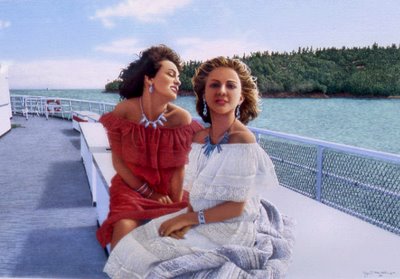
But I love ferries because they make my photographs of my daughters (and now my granddaughrers) look so romantic. The man who knew and knows about this is artist Jim McKenzie who lives on Mayne Island. In 1986 when Rosemary had more loose and spare change in our pockets we commissioned McKenzie for one of his then signature paintings which had as the location a BC Ferry usually sailing through Active Pass as in this reproduction of his painting here. That's Ale (now 39) on the left and Hilary (36, Rebecca and Lauren's mother). The original is on our dining room wall and there is not a day that I don't look at it and smile.
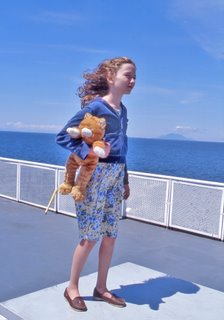
Today I picked up the slides I took over the weekend during our "holiday" in Parksville. These are two pictures of Rebecca in our trip back on board the Queen of Oak Bay.
I do hope McKenzie still finds the time to get the inspiration that I get on board BC Ferries, Sunshine Breakfast, be damned!
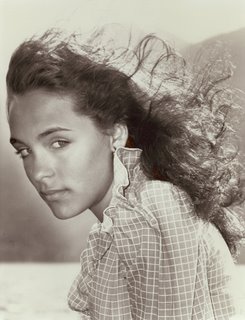
And that's Ale when she was 15 or 16 on the Bowen Island ferry.
Helena Bonham Carter's Bee-Stung Lips
Sunday, June 22, 2008
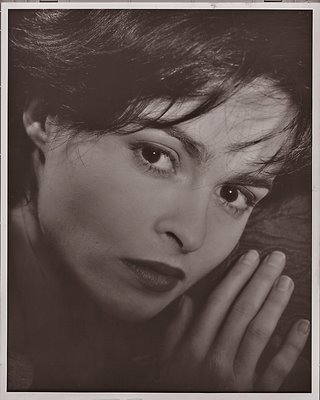
Today Rosemary, Lauren, Rebecca and I returned from three days at Pacific Shores Resort & Spa. I am to write about this experience for a magazine from Rebecca's point of view. It will be fun. Lauren (5) had to call her mother to tell her that they had a separate room with its own TV and a fridge that had real ice in it. Our rooms had three TVs as that third one was a bigger flat screen (all three were flat screens) in the sitting area. Paradoxically the pleasant and fun weekend was dampened somewhat (in a positive way) in that I saw Marion Bridge, Wiebke von Carolsfeld's film based on Daniel MacIvor's play. Best of all this depressingly wonderful film starred Molly Parker. It was further dampened by the strange 2003 Australian film (Michael Petroni) Till Human Voices Wake Us with Helena Bonham Carter.
The former one depressed me and the latter gave me nightmares last night. Today I thought on how TV and films can affect how we perceive a holiday and a weekend. It made me think of TV and my recollection of it.
I first saw a TV with something happening it in 1952 when Susan Stone (the daughter of the GM CEO in Buenos Aires sent his father's Cadillac to pick me up for a day at her home (a mansion). That initial TV program was a dull documentary on oil exploration. I remember the oil derricks. By 1955 I was addicted to watching Boston Blackie on our brand new Zenith in Mexico City. My addiction to the program coincided with a month-long binge on Delaware Punch. When I married Rosemary in 1968 I remember obsessing over Star Treck. In Mexico City it was called La Odisea del Espacio. It was dubbed into Mexico City Spanish (¡Chihuahua! ¡No están atacando los clingones! ). It was only in 1975 that I saw my first Star Treck in Vancouver in English. I became most confused when I saw my hero, Captain Kirk in Super Valu ads. I had no idea he was Canadian. Over the weekend on Bravo I observed that my captain has become a baffoon flogging fibre bars.
It was an add on dyslexia that I saw on TV sometime in 1977 that clued me in to the fact that I suffered this disorder. When my daughters arrived from school I did not hid my fondness for watching Gilligan's Island with them.
Rosemary always wanted a TV in our bedroom. I relented for a few months a few years ago when she had a foot operation. Her inaugural TV watching (Hitchcock's Vertigo) was marred by the death of her black cat (Mosca) of a heart seizure.
After that we compromised and we brought up the TV from our "TV room" in the cold basement to our den. It has been hard since to steer Rebecca or Lauren into the garden or to accompany us to VanDusen when they are watching their Saturday programs. The TV in the den has helped us choosy about the films we watch so we check the on line website of Turner Classic Movies channel.The former one depressed me and the latter gave me nightmares last night. Today I thought on how TV and films can affect how we perceive a holiday and a weekend. It made me think of TV and my recollection of it.
I first saw a TV with something happening it in 1952 when Susan Stone (the daughter of the GM CEO in Buenos Aires sent his father's Cadillac to pick me up for a day at her home (a mansion). That initial TV program was a dull documentary on oil exploration. I remember the oil derricks. By 1955 I was addicted to watching Boston Blackie on our brand new Zenith in Mexico City. My addiction to the program coincided with a month-long binge on Delaware Punch. When I married Rosemary in 1968 I remember obsessing over Star Treck. In Mexico City it was called La Odisea del Espacio. It was dubbed into Mexico City Spanish (¡Chihuahua! ¡No están atacando los clingones! ). It was only in 1975 that I saw my first Star Treck in Vancouver in English. I became most confused when I saw my hero, Captain Kirk in Super Valu ads. I had no idea he was Canadian. Over the weekend on Bravo I observed that my captain has become a baffoon flogging fibre bars.
It was an add on dyslexia that I saw on TV sometime in 1977 that clued me in to the fact that I suffered this disorder. When my daughters arrived from school I did not hid my fondness for watching Gilligan's Island with them.
Rosemary always wanted a TV in our bedroom. I relented for a few months a few years ago when she had a foot operation. Her inaugural TV watching (Hitchcock's Vertigo) was marred by the death of her black cat (Mosca) of a heart seizure.
This weekend's flat screen TV experience makes me wonder why all the actors had pasty complexions that looked Photoshoped with that special tool fo the wedding photography trade called Diffuse Glow.
I survived Friday night's viewing of Marion Bridge,but after Saturday's nights exposure of Till Human Voices Wake Us I felt a need to read T. S. Elliot's poem, Love Song of J. Alfred Prufrock and I renewed my admiration for anything with Helena Bonham Carter. In the NY Times review (Stphen Holden hatet the Australian film but loved the Canadian one) he writes of her, "Ms. Bonham Carter, with her bee-stung lips and witchy hair, has never looked more like an Aubrey Beardsley fantasy than she does in the role of the movie's resident sea-girl, Ruby."
How director Petroni interprets the last line of the Elliot's poem:
We have lingered in the chambers of the sea/By sea-girls wreathed with seaweed red and brown/Till human voices wake us, and we drown.
into the perplexing, complicated by ultimately satisfying ending did as much to unsettle me as in the last few minutes of Marion Bridge when Molly Parker looks at her father (ravaged by Alzheimer's) coldly (no actress that I know of can muster such a terryfing coldness and aloofness) and in an instant you know the real tragedy of this film.
And yes the weekend, in spite of laughing little girls and being taught to kayak by Rebecca (we didn't sink or turn over once!) was made sad, but all the better by TV.
Mother Earth Bites The Dust
Saturday, June 21, 2008
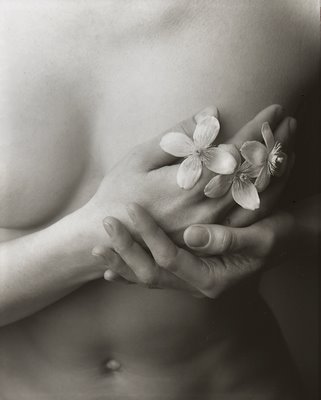
It has been my experience in the past that bits and pieces of human anatomy don't mix well with plants or plant parts. The usual results either look in bad taste and anything combining red roses with the female anatomy is a cliché. But here is an example that did work for me. I had to submit a photograph to a show in Calgary called Mother Earth. I consulted with Katheryn Petersen who contributed her fine chest while my Clematis 'Montana' did the rest. Since this picture was taken the clematis died (it may have been around 40 years old) and as far as I know Peterson and her chest are just fine.
A Red Gift Horse - Crimson Glory
Friday, June 20, 2008
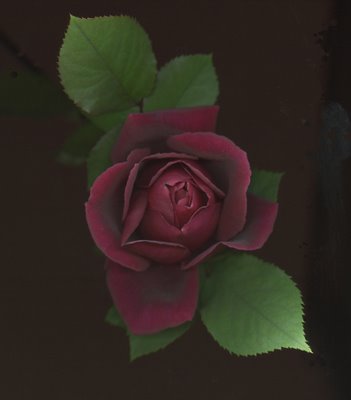
Just about every plant in our garden either Rosemary or I have chosen. Many of the roses were suggested by Janet Wood. Just about every suggestion of hers has been a very good rose. Only two people have imposed on me a rose. I was given no choice. Alleyne Cook showed up one day with a little pot that had a stick in it. He told me, "If you are going to have one rose in your garden it has to be Rosa 'Complicata'. The stick grew well and this once blooming rose makes up for it with hundreds of very large single deep pink flowers. The other unwanted rose was given to me by John Tuytle.
Last year he and his wife were very sick. I was to visit him with Rebecca. I never did. John was much too sick. This year he called and he expects our visit. But on his way to leave some plants for the VanDusen plant sale he dropped off a small pot with a Hybrid Tea Rose called Crimson Glory. Hybrid Teas are certainly not my cup of tea. The ones that have scent I don't like (with the exception of a hard to grow Double Delight. It is struggling in my garden at the time.) I don't like the scent oof most teas because while sweet it seems cold and standoffish to me.
In 1935 Crimson Glory was the finest red Hybrid Tea on earth. It had been introduced by Wilhelm Kordes. In time it seems to have faded and it has been replaced by other red roses like Mr. Lincoln. I like none of them. I would rather have my once blooming Gallicas or the English Rose L.D. Braithwaite.
John Tuytle, in the end was right. This is the first bloom from his plant. The red is deep and the insides of the petals are almost jet black. And the scent! It is not Tea Rose at all. It smells of fruits. From what I have read it seems that my gift horse has sired lots of very popular offspring. It lives in other plants. In my garden it lives on its own.
Patrice Visits My Garden
Thursday, June 19, 2008
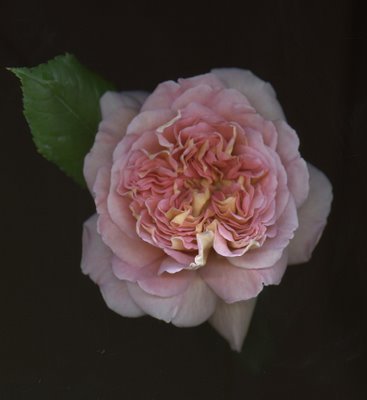
Yesterday I had a visitor in my garden. I had not seen Patrice Bilawka for about 8 years. Those 8 years have been more than kind to her. She is even more of a woman and in the right places, too. It seems she is back to stay in Canada. She says she is tired of the heat and constant sun of Los Angeles. Can that be possible? My roses are having a hard time with our long cool and wet spring. But there were enough roses open yesterday and I gave Patrice a tour. We then had grilled ham and
Swiss pannini and sliced tomatoes. We drank my recent favourite tea, Kalami Assam.
As we looked at the garden and I made Patrice smell the roses I told her that at this time of the year, I don't want to think of anything, including sex. All want to do is go outside in the early morning to look and smell the roses and to find which new rose is jut out to greet me.
Today I cut this specimen of the English Rose Abraham Darby. It is 5 inches across and the perfume is strong and intoxicating. It smells of a mixture of fruit including a hint of the granadine they used to put in my vanilla ice cream sodas in Buenos Aires when I was a boy. I looked at Patrice in the eye when I told her about my non interest in sex. Her smile was demure and I can only hope that this other sumptuous specimen of beauty that she is just might pose for my camera again.
I just might forget Abraham Darby and all the others. For a while.
Rosa 'Madame Alfred Carrière' & My Daughter The Jerk
Wednesday, June 18, 2008
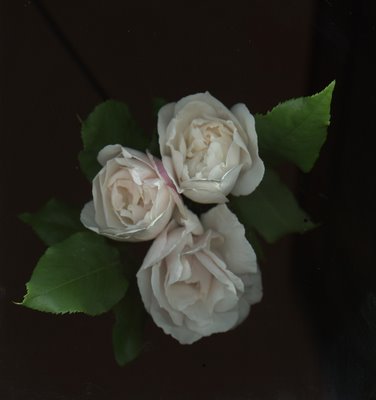
On Wednesday afternoons I pick up Rebecca at home and take her to her ballet class. When her class is over we go to Opera Sushi. Today was different. When I arrived at Rebecca's I was told by Hilary (her mother and my daughter) that Rebecca was punished because she had called her mother a jerk. She was not to go to Opera Sushi with me after her class. Rebecca does not like to be rushed into dressing (in this case into her ballet clothes) so she reacted accordingly. Hilary knows that traffic is bad at 5:30 so I have to leave on time. Rebecca said, "I really didn't want to go to sushi, anyway." At that point I stepped in and told her that if she said anything after I finished speaking I had the power to ground her (this means no computer and no TV for several days). Rebecca was quiet. In the car she had a few tears but I said nothing.
When I picked her up (a bit angry inside since I was not going to have the pleasure of her company at Opera Sushi) I also said nothing but I stopped at a coffee shop and told Rebecca we were going to have a chat. She got confrontational but we finally sat down.
I told her that many of the roses in my garden that were from the 19th century gave women no direct credit. I gave as examples Rosa 'Madame Pierre Oget', Madame de Brunel (her husband was famous), Madame Isaac Pereirie and finally Madame Alfred Carrière. I explained that not too long ago her mother would have been Mrs. Bruce Stewart and her grandmother Mrs. Jorge Waterhouse-Hayward. I explained that women had fought to be respected and to be called by their name. So roses increasingly were given names of women, independent of their husbands such as Madame Hardy or Mrs. Oakley Fisher. And modern roses like Jacqueline du Pre or Mary Webb celebrate women all on their own.
Rebecca understood what I was driving at. "I should not have called her a jerk, " she said to me apologetically. Perhaps Rosa 'Madame Alfred Carrière' was in my mind as she has been blooming for the last couple of days. Her flowers are all white if seen from far but when you get close you will notice a faint but attractive pink blush. Her scent is heavenly and today like an angel that she is she helped me bring Rebecca around.
Rebecca responds to logic and she understood that on Wednesdays, just before I arrive to pick her up she is statistically (she knows the meaning of this word) poised to have a fight with her mother. She told me she was going to try her best to avoid that mathematical possibility.
Tuesday, June 17, 2008
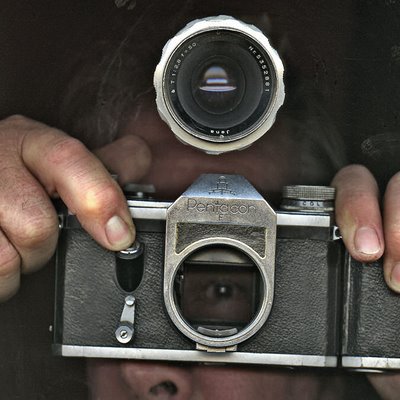
In 1959 Brother Emmett who was in charge of the St Ed's school bookstore and the mail kept nodding negatively every time I passed to enquire if I had a package. But one day (I remember it was very hot so it must have been an early Austin, Texas spring) he nodded positively and handed me a big and quite heavy package. Inside was the most beautiful glossy box I had ever seen. From it I pulled out my first serious camera, a Pentacon-F with an f-2.8 50mm Zeiss Tessar lens. The package had come from Olden Cameras in New York City. I had purchased an Agfa sillette the year before on a trip to Wahsington DC. The only two things both cameras had in common was that were German and they were shiny. This era, the 50s, is sometimes called the photographic chrome age.
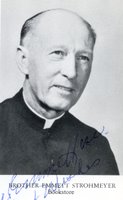
Holding the Pentacon-F was magic. The world was there for me to capture (in a 50s sense of the word not in the modern digital capture meaning) and to control. I immediately felt frustrated when I found out that my Spanish teacher, Brother Anton had the same camera but with a superior and faster 58mm Zeiss Biotar. Within a year Brother Edwin, who taught me religion and forced me to learn to play the alto saxophone in the school band had purchased a new-fangled Japanese Konica.
More insult was added with furtherinjury, that Christmas when I was in Mexico City. My Uncle Tony showed up with an exotic camera I had never heard of called a Nikon SP. He told me my East German Pentacon was junk and that the future of cameras was in Japan. I was too respectful to point out that he was full of ...But the damaging seeds of doubt began to slip into my mind. I felt terrible. Then my friend Howard Houston from Austin came to visit me in 1961.He brought a Miranda Reflex that had all kinds of refinements and a faster lens. I was plain jealous.

I went to the Monte de Piedad, the Mexico City government pawn shop and spotted Mirandas that were all well over my budget. It was in Foto Rudiger, On Venustiano Carranza Street, downtown that I finally found a roughed up Pentax S-3 with a semi-automatic F-2 lens and, low and behold, with an innovation that was called an instant return mirror.
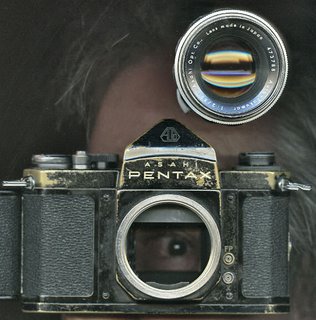
These cameras and even the "more recent" ones of my working collection like a heavy, black and serious looking Nikon F-3 with a huge motor drive that has more torque than a Toyota Prius, have a feel, a look, a beauty that the modern cameras do not have. It may have something to do with the fact that I sometimes think in Spanish. in Argentina plastic was always rendered as material plástico. It sounded and still sound cheap.
But I think there is another element here. I remember being able to open the doors of 50s vintage Chevrolets, Buicks and Oldsmobiles. On the sill you could read a beautiful stamp on the metal that said Body by Fisher. There was a pride in the ownership of such a car. My wife's Audi lacks that mystique even if it is a darn better car than those Bodies by Fishers from the Chrome Age.
Who can forget the look of the all black Canon F-1? It had the look of a modern Hummer except it seemed more authentic in its apparent beefy indistructability.
Things began to change for the worse when Olympus started selling units that featured ESP! Iamgine losing control to your mother-in-law. That's what ESP meant.
Now the image of a modern photographer is not of one looking through his or her camera to take a picture but of one looking at the back of it with a puzzled look.
Not too long ago a distinguished gentleman of a premier car dealership reacted to my comment of wanting to look under the hood of an Aston Martin. "There is nothing underneath, " he said, sadly, "It is just a Ford engine."
The magic of my East German Pentacon, the Pentax S-3, my Nikon FM-2s, the venerable F-3 is still in them. I can feel it when I hold them. The world still feels conquerable. But when I look at what cameras have become the seem to be Aston Martins with Ford Engines.
That Pentax S-3 still works as does my first, untarnished, but faded first love, My Pentacon F. Paul Leisz, my Hungarian bus driver friend came over on Sunday. He took pictures of my plants with his mildly expensive Nikon DSLR (digital single lens reflex). The pictures were all over-exposed. I metered the scene with my formerly state-of-the-art Minolta Flash Meter VF. I gave Paul the correct setting for his camera and told him to put it in manual. When he did the camera did not fire. "It will not allow me to take a picture because it thinks it is the wrong exposure." Imagine that! His mother-in-law is in control.

In 1959 Brother Emmett who was in charge of the St Ed's school bookstore and the mail kept nodding negatively every time I passed to enquire if I had a package. But one day (I remember it was very hot so it must have been an early Austin, Texas spring) he nodded positively and handed me a big and quite heavy package. Inside was the most beautiful glossy box I had ever seen. From it I pulled out my first serious camera, a Pentacon-F with an f-2.8 50mm Zeiss Tessar lens. The package had come from Olden Cameras in New York City. I had purchased an Agfa sillette the year before on a trip to Wahsington DC. The only two things both cameras had in common was that were German and they were shiny. This era, the 50s, is sometimes called the photographic chrome age.

Holding the Pentacon-F was magic. The world was there for me to capture (in a 50s sense of the word not in the modern digital capture meaning) and to control. I immediately felt frustrated when I found out that my Spanish teacher, Brother Anton had the same camera but with a superior and faster 58mm Zeiss Biotar. Within a year Brother Edwin, who taught me religion and forced me to learn to play the alto saxophone in the school band had purchased a new-fangled Japanese Konica.
More insult was added with furtherinjury, that Christmas when I was in Mexico City. My Uncle Tony showed up with an exotic camera I had never heard of called a Nikon SP. He told me my East German Pentacon was junk and that the future of cameras was in Japan. I was too respectful to point out that he was full of ...But the damaging seeds of doubt began to slip into my mind. I felt terrible. Then my friend Howard Houston from Austin came to visit me in 1961.He brought a Miranda Reflex that had all kinds of refinements and a faster lens. I was plain jealous.

I went to the Monte de Piedad, the Mexico City government pawn shop and spotted Mirandas that were all well over my budget. It was in Foto Rudiger, On Venustiano Carranza Street, downtown that I finally found a roughed up Pentax S-3 with a semi-automatic F-2 lens and, low and behold, with an innovation that was called an instant return mirror.

These cameras and even the "more recent" ones of my working collection like a heavy, black and serious looking Nikon F-3 with a huge motor drive that has more torque than a Toyota Prius, have a feel, a look, a beauty that the modern cameras do not have. It may have something to do with the fact that I sometimes think in Spanish. in Argentina plastic was always rendered as material plástico. It sounded and still sound cheap.
But I think there is another element here. I remember being able to open the doors of 50s vintage Chevrolets, Buicks and Oldsmobiles. On the sill you could read a beautiful stamp on the metal that said Body by Fisher. There was a pride in the ownership of such a car. My wife's Audi lacks that mystique even if it is a darn better car than those Bodies by Fishers from the Chrome Age.
Who can forget the look of the all black Canon F-1? It had the look of a modern Hummer except it seemed more authentic in its apparent beefy indistructability.
Things began to change for the worse when Olympus started selling units that featured ESP! Iamgine losing control to your mother-in-law. That's what ESP meant.
Now the image of a modern photographer is not of one looking through his or her camera to take a picture but of one looking at the back of it with a puzzled look.
Not too long ago a distinguished gentleman of a premier car dealership reacted to my comment of wanting to look under the hood of an Aston Martin. "There is nothing underneath, " he said, sadly, "It is just a Ford engine."
The magic of my East German Pentacon, the Pentax S-3, my Nikon FM-2s, the venerable F-3 is still in them. I can feel it when I hold them. The world still feels conquerable. But when I look at what cameras have become the seem to be Aston Martins with Ford Engines.
That Pentax S-3 still works as does my first, untarnished, but faded first love, My Pentacon F. Paul Leisz, my Hungarian bus driver friend came over on Sunday. He took pictures of my plants with his mildly expensive Nikon DSLR (digital single lens reflex). The pictures were all over-exposed. I metered the scene with my formerly state-of-the-art Minolta Flash Meter VF. I gave Paul the correct setting for his camera and told him to put it in manual. When he did the camera did not fire. "It will not allow me to take a picture because it thinks it is the wrong exposure." Imagine that! His mother-in-law is in control.
Monday, June 16, 2008
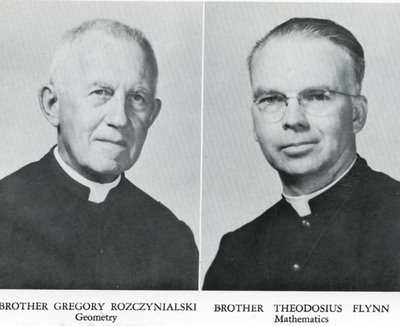
As I write this, 11:15 Sunday night it is still father's day. I have been thinking about it all day. In the afternoon the Waterhouse-Haywards (Rosemary and I ) and the Stewarts (Hilary, Bruce, Lauren, Rebecca and the grandparents Nana and Doug) we all had chicken at my favourite place, Nando's on 41st. I was sitting in a corner so I had time to think.
I wrote about my father and the little I knew him here and here.
In 1957 when I finished grade 8 in Nueva Rosita, Coahuila Mexico my mother had few options. She could send me to the conventional state schools. But my mother wanted the best for me so she decided to send me to the nearest boarding school in the US. That happened to be St. Edwards in Austin, Texas.
Little I was to know when I arrived ( I remember crying I missed my mother so much) that I was going to have many surrogate fathers who would each teach me something of value and in such a way that somehow I would grow up to be of some use to society without too many complexes as baggage. In no special order here they are.
Brother Gregory and Brother Theodosius
It is appropriate that Brother Gregory and Brother Theodosius (photo above, left) sit side by side in my 1960 Edwardian (the name of our yearbook). I never got to know them well because I only had them as teachers and I never dealt with them as dorm prefects, etc. Brother Gregory was always cheerful and warm. From him I learned the perfect beauty of plane geometry and how neat and tidy its two dimensions were. With his class under my belt I was not quie prepared to the cold and precise Brother Theodosious. We were almost afraid of him simply because of his stern face. He never punished us or shouted at us. But then, we never misbehaved. I was able to discern his love for how mathematics worked in an ordered universe. When years later I learned to calculate the volume of a sphere using the calculus I understood (if only for a few seconds) how unimportant our complicated human lives are in comparison to understanding the comparative simplicity of mathematics.
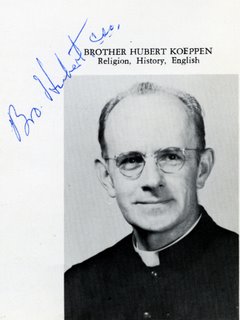
Brother Hubert
Of all the brothers I got to know Brother Hubert most. Besides teaching me ancient history I learned to be frugal. He re-used everything and years later, after he died, they found in his two rooms up the attic of our neo-Gothic building that he had been a prodigious pack rack. Rumours state that there was a fully assembled Model T Ford up there. How did he get it up there? I spent long hours re-winding dance streamers in the school shop that he ran. We chatted. He never gossiped or ever said bad stuff about anybody else. But what he taught me best was to love history and in spite of wars and famine to see the positive. If anything he prepared me to read, comprehend and appreciate the books of Teilhard de Chardin.
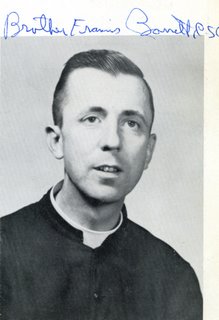
Brother Francis
I have had a bad back for a week and going up and down the stairs is excruciating. I understand now the terrible pain that Brother Francis lived with. He always walked stooped over (even though he was a young man) like Groucho Marx. He looked and talked like a living saint. I don't think I ever saw him lose his temper. He was a living example of absolute equanimity. He taught me American history and he did it with so much passion that to this day I think I have an edge when I read articles in the NY Times about primaries and caucuses. He taught me to be curious about people so that I wanted to read more about them. Brother Francis must have been a lefty because I learned to love President Franklin Delano Roosevelt. And I could tell you all about Sacco and Vanzetti, and the Dred Scott Decision.
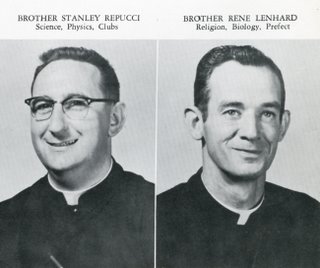
Brother Stanley
From Brother Stanley I learned stuff that would probably have landed him in jail because of an SPCA complaint. After all, he devised contests in his biology class where the prize for keeping a dissected frog alive the longest was a box of cigars. I won a box once. His physics class was so difficult that I dropped it. He looked me straight in the face (and when he was serious he was scary) and told me, "It is difficult to quit. But the more you do it the easier it gets. Soon you will be quitting anything and everything that is too hard." I still dropped his class but after that I stuck to my guns with just about everything else. Brother Stanley taught me to be persistent and to love pizza.
Brother Rene
Brother Rene was a brother who never taught me in class since I only had him as dorm prefect in grade 10. He was the one who played classical music (or Amos and Andy) after lights out over the dorm sound system. He wore short Wellington boots with one of his pant legs casually semi tucked in. I thought it very cool so I bought the same boots. I admired his masculinity and of all the brothers at the St Ed's he was my male/father figure role model. We rarely misbehaved because we had a quiet respect for him. He wasn't warm, he wasn't cold. He kept his distance just right.
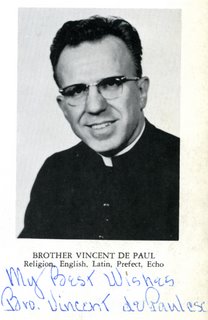
Brother Vincent
I had Brother Vincent for English and as dorm prefect in my grade 9. He was a sculptor so I learned, through his example, to love the arts, specially painting and sculpture. He took our class to Washington DC and I was so struck by its beauty that I have returned many times since.
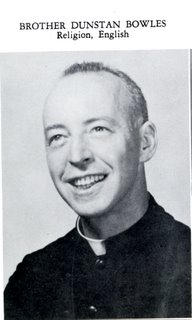
Brother Dunstan
Brother Dunstan was my English and English lit teacher. He was hip. He told us about a young English playwright called Pinter. I love Shakespeare because of Brother Dunstan. Even though he had infinite patience he called me in one day and told me, "Unless you improve your handwriting, which is currently illegible, I will not read your homework assignments anymore." For better or for worse I so admired Brother Dunstan's class that I became an insufferable elitist snob.
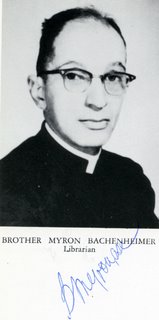
Brother Myron
Brother Myron had a short temper and when he lost it he yelled at us in German. We loved to pick on him (we were very cruel) and see how short his fuse was. But on a one on one basis he was mild, quiet, extremely intelligent and kind. So I went to him and told him about my handwriting problem. Brother Myron told me, "Go and buy an italic nib for your Esterbrook pen and I will teach you how to write legibly." This he did but to an extreme. I had to buy another pen so I could have two nibs. One was for black ink and one for red ink. The red ink pen I used to write much larger capital letters for the beginning of paragraphs. Brother Myron taught me to make complex capital letters with lots of flourishes. Brother Dunstan gave me A+s for my essays.
I had to buy another pen so I could have two nibs. One was for black ink and one for red ink. The red ink pen I used to write much larger capital letters for the beginning of paragraphs. Brother Myron taught me to make complex capital letters with lots of flourishes. Brother Dunstan gave me A+s for my essays.
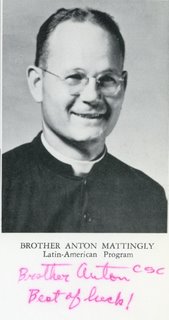
Brother Anton
One year I decided to take Spanish. I was simply lazy. German and Latin involved too much work. Brother Anton taught Spanish and he managed to not be intimidated by the one student in his class who spoke the language perfectly, me. He taught me grammar. My lack of proper grammar meant that when I tried to use logic it failed me as Spanish grammar is not all that logical. Brother Anton had a Pentacon F camera with a F-2 Biotar lens. My Pentacon F with its F-2.8 Tessar lens was a tad inferior. But we compared notes on what in those years, 1956 was a new-fangled type of camera. It was called a single lens reflex.
Brother Edwin
Of Brother Edwin I have written lots here and and here and in many more places but this will suffice. I think that of all the brothers listed here Brother Edwin is the only one who is alive. I correspond with him with frequency.
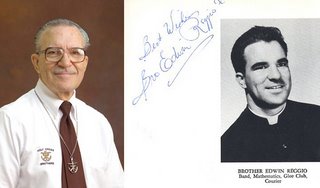
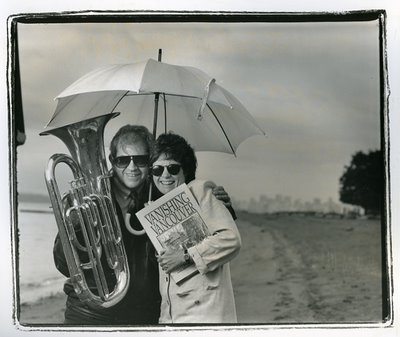
The CBC has not figured in a positive way in a couple of my blogs lately:
1.CBC Vancouver Orchestra.
2.Hockey Night In Canada Theme Song.
But I must attempt to go positive with this broadcasting corporation that has brought me so much pleasure, knowledge, friends and my first photographic job in Canada.
This positive story begins with a positive but negative contribution via an email remark on my Hockey Night In Canada blog. It came from Sharman King (seen here in a photograph I took for Quill & Quire in 1995. I have forgotten who the woman with him is who is holding Michael Cluckner's book.) who is both the owner of The Book Warehouse and a professional muusician who plays the trombone and the bass horn for the Vancouver Opera Symphony. Whenever I go to the opera I chat with him when I look down on the orchestra pit. Sharman King is a man with passion for music. And this is what he had to add on Dolores Claman's Hockey Night In Canada Theme Song:
comments:
I don't know if you will remember the original version of
the theme, orchestrated by Dolores' partner Jerry Toth. Arni
Chykoski, who grew up in New Westminster, was the lead
trumpet, arguably the best lead trumpet player in a big band
setting, ever. His last six notes of that original version
were simply stunning in their perfection and ring in my head
to this day.
In their search for a younger demographic (which they will
probably never attract) they're removing many of the ties
that bind us.
Sharman King has found the real reason why I am so upset with all the CBC changes. It is in that last paragraph. But:
When I first started taking pictures of variety shows at the CBC in the mid 70s I felt that I was an outsider as a free lancer. I was not part of an institution. There was no esprit de corps for me and I could not share the complaints (part of that institution!) of my new CBC friends about the "mother corporation". But friends like cameraman Michael Varga, other cameramen, or employees in lighting and staging made me feel at home. One of the places I felt at home at the CBC was the cafeteria. Through the years many attempts were made to improve the food in spite of the constant jokes about CBC cafeterias in Wayne & Shuster (I was a fan!). The food, at best was adequate. The company was special and the highlight was a Shadbolt triptych mural on the west wall. At first I didn't notice it but with familiarity I began to appreciate is happy colours.
The CBC cafeteria was finally closed and coverted into a radio studio. The Shadbolt vanished. Every once in a while I would ask but I was always given an, "I don't know answer." It may have been either Paul Grant or Michale Juk who passed on my request to the building manager. The man called me one day and took me to a basement where I saw the mural. He explained, "We currently have no room for it and it would be a pity to put in on one our many halways. They are too narrow for anybody to appreciate the mural. Don't worry it's safe with us and as soon as we find space for it, we will put it up. "
In any of the Latinamerican countries I have been in that mural would have ended its days in some executive's living room. It is a relief to be in Canada where there is still some accountability.
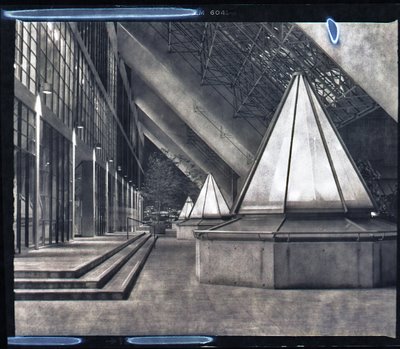
I believe that Vancouver is not kind or respectful to its architects. When the CBC Vancouver building was finished in the 70s it won its architect, Paul Merrick (working for the venerable city firm, Thompson Berwick and Pratt) a Governor General's award. I always liked the building even though many who had to work in it didn't. Now that the building is being "improved" and will have a condo attached to it, I hope room will be found to display that Jack Shadbolt mural. Not only will I smile but I am sure Sharman King will, too.
another Shadbolt.
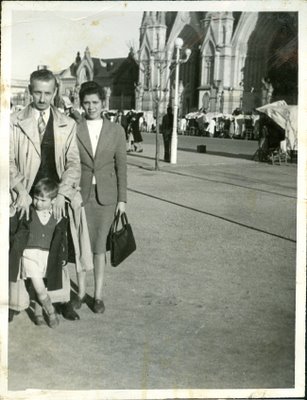
I was with my father for 11 years. I remember few of them as he left home when I was 9 and I only saw him on some weekends. Then when I was 20 I returned to Buenos Aires from Mexico. I had told my mother that I felt patriotic and that I had to serve my country. That's how I ended up as a conscript for the Argentine navy for two years. I never told her that the real reason was that I wanted to find my father. It took a while and I found him. We spent about five month's worth of Sundays before he died. Of these conversations I remember next to nothing. I have always thought I had a good memory but somehow the sinapses here have failed me. Answers to questions which I should have asked have remained unanswered because I never asked them. There is nobody alive now that could answer them for me.
Sometime in 1951, when I was 9 I asked my father, "Your favorite books on your book shelf are by Leslie Charteris. Why do you read books written by a woman?" "Sit down, Alex,""he said, "I will explain. Leslie Charteris is a man and his hero is called Simon Templar otherwise known as The Saint. Leslie is an epicene name. This means that it is a name that can be both a girl's or a boy's. If you were called Leslie it would be up to you to make sure everybody knew it was a man's name."
When my second daughter was born I insisted that she have an epicene name. So we named her Hilary.
Today Rebecca made an apple pie from scratch. I called her up from Safeway and asked her to call me back with the ingredients to buy. Hilary thought this was a project that would be perhaps too tough to handle. Hilary did not count on the fact that Rebecca had observed her make apple pies many times (Hilary's apple pies are famous in our family.) so she knew what to do. We had both Mike Varga (visible in last picture) and Abraham Rogatnick for dinner. The pie was excellent.
When I was 8 I distinctly remember helping my father with the making and the cooking of candied (they were green, not red!) apples. I felt so proud and told everybody I had made them. Could this have been the reason why I called Rebecca from Safeway on the apple pie?
In the picture above I am with my father and mother outside the neo-Gothic church in Luján in the Province of Buenos Aires. It was taken in 1947 when I was 5.

As I write this, 11:15 Sunday night it is still father's day. I have been thinking about it all day. In the afternoon the Waterhouse-Haywards (Rosemary and I ) and the Stewarts (Hilary, Bruce, Lauren, Rebecca and the grandparents Nana and Doug) we all had chicken at my favourite place, Nando's on 41st. I was sitting in a corner so I had time to think.
I wrote about my father and the little I knew him here and here.
In 1957 when I finished grade 8 in Nueva Rosita, Coahuila Mexico my mother had few options. She could send me to the conventional state schools. But my mother wanted the best for me so she decided to send me to the nearest boarding school in the US. That happened to be St. Edwards in Austin, Texas.
Little I was to know when I arrived ( I remember crying I missed my mother so much) that I was going to have many surrogate fathers who would each teach me something of value and in such a way that somehow I would grow up to be of some use to society without too many complexes as baggage. In no special order here they are.
Brother Gregory and Brother Theodosius
It is appropriate that Brother Gregory and Brother Theodosius (photo above, left) sit side by side in my 1960 Edwardian (the name of our yearbook). I never got to know them well because I only had them as teachers and I never dealt with them as dorm prefects, etc. Brother Gregory was always cheerful and warm. From him I learned the perfect beauty of plane geometry and how neat and tidy its two dimensions were. With his class under my belt I was not quie prepared to the cold and precise Brother Theodosious. We were almost afraid of him simply because of his stern face. He never punished us or shouted at us. But then, we never misbehaved. I was able to discern his love for how mathematics worked in an ordered universe. When years later I learned to calculate the volume of a sphere using the calculus I understood (if only for a few seconds) how unimportant our complicated human lives are in comparison to understanding the comparative simplicity of mathematics.

Brother Hubert
Of all the brothers I got to know Brother Hubert most. Besides teaching me ancient history I learned to be frugal. He re-used everything and years later, after he died, they found in his two rooms up the attic of our neo-Gothic building that he had been a prodigious pack rack. Rumours state that there was a fully assembled Model T Ford up there. How did he get it up there? I spent long hours re-winding dance streamers in the school shop that he ran. We chatted. He never gossiped or ever said bad stuff about anybody else. But what he taught me best was to love history and in spite of wars and famine to see the positive. If anything he prepared me to read, comprehend and appreciate the books of Teilhard de Chardin.

Brother Francis
I have had a bad back for a week and going up and down the stairs is excruciating. I understand now the terrible pain that Brother Francis lived with. He always walked stooped over (even though he was a young man) like Groucho Marx. He looked and talked like a living saint. I don't think I ever saw him lose his temper. He was a living example of absolute equanimity. He taught me American history and he did it with so much passion that to this day I think I have an edge when I read articles in the NY Times about primaries and caucuses. He taught me to be curious about people so that I wanted to read more about them. Brother Francis must have been a lefty because I learned to love President Franklin Delano Roosevelt. And I could tell you all about Sacco and Vanzetti, and the Dred Scott Decision.

Brother Stanley
From Brother Stanley I learned stuff that would probably have landed him in jail because of an SPCA complaint. After all, he devised contests in his biology class where the prize for keeping a dissected frog alive the longest was a box of cigars. I won a box once. His physics class was so difficult that I dropped it. He looked me straight in the face (and when he was serious he was scary) and told me, "It is difficult to quit. But the more you do it the easier it gets. Soon you will be quitting anything and everything that is too hard." I still dropped his class but after that I stuck to my guns with just about everything else. Brother Stanley taught me to be persistent and to love pizza.
Brother Rene
Brother Rene was a brother who never taught me in class since I only had him as dorm prefect in grade 10. He was the one who played classical music (or Amos and Andy) after lights out over the dorm sound system. He wore short Wellington boots with one of his pant legs casually semi tucked in. I thought it very cool so I bought the same boots. I admired his masculinity and of all the brothers at the St Ed's he was my male/father figure role model. We rarely misbehaved because we had a quiet respect for him. He wasn't warm, he wasn't cold. He kept his distance just right.

Brother Vincent
I had Brother Vincent for English and as dorm prefect in my grade 9. He was a sculptor so I learned, through his example, to love the arts, specially painting and sculpture. He took our class to Washington DC and I was so struck by its beauty that I have returned many times since.

Brother Dunstan
Brother Dunstan was my English and English lit teacher. He was hip. He told us about a young English playwright called Pinter. I love Shakespeare because of Brother Dunstan. Even though he had infinite patience he called me in one day and told me, "Unless you improve your handwriting, which is currently illegible, I will not read your homework assignments anymore." For better or for worse I so admired Brother Dunstan's class that I became an insufferable elitist snob.

Brother Myron
Brother Myron had a short temper and when he lost it he yelled at us in German. We loved to pick on him (we were very cruel) and see how short his fuse was. But on a one on one basis he was mild, quiet, extremely intelligent and kind. So I went to him and told him about my handwriting problem. Brother Myron told me, "Go and buy an italic nib for your Esterbrook pen and I will teach you how to write legibly." This he did but to an extreme.
 I had to buy another pen so I could have two nibs. One was for black ink and one for red ink. The red ink pen I used to write much larger capital letters for the beginning of paragraphs. Brother Myron taught me to make complex capital letters with lots of flourishes. Brother Dunstan gave me A+s for my essays.
I had to buy another pen so I could have two nibs. One was for black ink and one for red ink. The red ink pen I used to write much larger capital letters for the beginning of paragraphs. Brother Myron taught me to make complex capital letters with lots of flourishes. Brother Dunstan gave me A+s for my essays.
Brother Anton
One year I decided to take Spanish. I was simply lazy. German and Latin involved too much work. Brother Anton taught Spanish and he managed to not be intimidated by the one student in his class who spoke the language perfectly, me. He taught me grammar. My lack of proper grammar meant that when I tried to use logic it failed me as Spanish grammar is not all that logical. Brother Anton had a Pentacon F camera with a F-2 Biotar lens. My Pentacon F with its F-2.8 Tessar lens was a tad inferior. But we compared notes on what in those years, 1956 was a new-fangled type of camera. It was called a single lens reflex.
Brother Edwin
Of Brother Edwin I have written lots here and and here and in many more places but this will suffice. I think that of all the brothers listed here Brother Edwin is the only one who is alive. I correspond with him with frequency.

The CBC & The Ties That Bind Us
Sunday, June 15, 2008

The CBC has not figured in a positive way in a couple of my blogs lately:
1.CBC Vancouver Orchestra.
2.Hockey Night In Canada Theme Song.
But I must attempt to go positive with this broadcasting corporation that has brought me so much pleasure, knowledge, friends and my first photographic job in Canada.
This positive story begins with a positive but negative contribution via an email remark on my Hockey Night In Canada blog. It came from Sharman King (seen here in a photograph I took for Quill & Quire in 1995. I have forgotten who the woman with him is who is holding Michael Cluckner's book.) who is both the owner of The Book Warehouse and a professional muusician who plays the trombone and the bass horn for the Vancouver Opera Symphony. Whenever I go to the opera I chat with him when I look down on the orchestra pit. Sharman King is a man with passion for music. And this is what he had to add on Dolores Claman's Hockey Night In Canada Theme Song:
comments:
I don't know if you will remember the original version of
the theme, orchestrated by Dolores' partner Jerry Toth. Arni
Chykoski, who grew up in New Westminster, was the lead
trumpet, arguably the best lead trumpet player in a big band
setting, ever. His last six notes of that original version
were simply stunning in their perfection and ring in my head
to this day.
In their search for a younger demographic (which they will
probably never attract) they're removing many of the ties
that bind us.
Sharman King has found the real reason why I am so upset with all the CBC changes. It is in that last paragraph. But:
When I first started taking pictures of variety shows at the CBC in the mid 70s I felt that I was an outsider as a free lancer. I was not part of an institution. There was no esprit de corps for me and I could not share the complaints (part of that institution!) of my new CBC friends about the "mother corporation". But friends like cameraman Michael Varga, other cameramen, or employees in lighting and staging made me feel at home. One of the places I felt at home at the CBC was the cafeteria. Through the years many attempts were made to improve the food in spite of the constant jokes about CBC cafeterias in Wayne & Shuster (I was a fan!). The food, at best was adequate. The company was special and the highlight was a Shadbolt triptych mural on the west wall. At first I didn't notice it but with familiarity I began to appreciate is happy colours.
The CBC cafeteria was finally closed and coverted into a radio studio. The Shadbolt vanished. Every once in a while I would ask but I was always given an, "I don't know answer." It may have been either Paul Grant or Michale Juk who passed on my request to the building manager. The man called me one day and took me to a basement where I saw the mural. He explained, "We currently have no room for it and it would be a pity to put in on one our many halways. They are too narrow for anybody to appreciate the mural. Don't worry it's safe with us and as soon as we find space for it, we will put it up. "
In any of the Latinamerican countries I have been in that mural would have ended its days in some executive's living room. It is a relief to be in Canada where there is still some accountability.

I believe that Vancouver is not kind or respectful to its architects. When the CBC Vancouver building was finished in the 70s it won its architect, Paul Merrick (working for the venerable city firm, Thompson Berwick and Pratt) a Governor General's award. I always liked the building even though many who had to work in it didn't. Now that the building is being "improved" and will have a condo attached to it, I hope room will be found to display that Jack Shadbolt mural. Not only will I smile but I am sure Sharman King will, too.
another Shadbolt.
My Father, Epicene Names - No Saint At Luján
Saturday, June 14, 2008

I was with my father for 11 years. I remember few of them as he left home when I was 9 and I only saw him on some weekends. Then when I was 20 I returned to Buenos Aires from Mexico. I had told my mother that I felt patriotic and that I had to serve my country. That's how I ended up as a conscript for the Argentine navy for two years. I never told her that the real reason was that I wanted to find my father. It took a while and I found him. We spent about five month's worth of Sundays before he died. Of these conversations I remember next to nothing. I have always thought I had a good memory but somehow the sinapses here have failed me. Answers to questions which I should have asked have remained unanswered because I never asked them. There is nobody alive now that could answer them for me.
Sometime in 1951, when I was 9 I asked my father, "Your favorite books on your book shelf are by Leslie Charteris. Why do you read books written by a woman?" "Sit down, Alex,""he said, "I will explain. Leslie Charteris is a man and his hero is called Simon Templar otherwise known as The Saint. Leslie is an epicene name. This means that it is a name that can be both a girl's or a boy's. If you were called Leslie it would be up to you to make sure everybody knew it was a man's name."
When my second daughter was born I insisted that she have an epicene name. So we named her Hilary.
Today Rebecca made an apple pie from scratch. I called her up from Safeway and asked her to call me back with the ingredients to buy. Hilary thought this was a project that would be perhaps too tough to handle. Hilary did not count on the fact that Rebecca had observed her make apple pies many times (Hilary's apple pies are famous in our family.) so she knew what to do. We had both Mike Varga (visible in last picture) and Abraham Rogatnick for dinner. The pie was excellent.
When I was 8 I distinctly remember helping my father with the making and the cooking of candied (they were green, not red!) apples. I felt so proud and told everybody I had made them. Could this have been the reason why I called Rebecca from Safeway on the apple pie?
In the picture above I am with my father and mother outside the neo-Gothic church in Luján in the Province of Buenos Aires. It was taken in 1947 when I was 5.
Friday, June 13, 2008
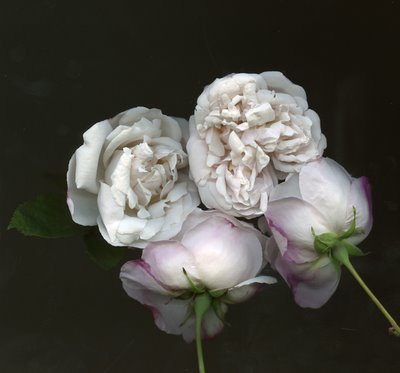
It was sometime around 1977 that I met a beautiful and tiny French Canadian soprano, Ginette Duplessis. I had met her through the Vancouver French CBC Radio station. I wrote about her famous pair and Pernod recipe here.
Ginette again was in my memory today. In spite of the cloudy and rainy days a rose that all these years has been most reluctant to do anything except get downy mildew on it leaves finally is blooming as if there were no tomorrow. The rose is extremely rare in our parts. It is Rosa 'Splendens'. It is sometimes called 'Ayrshire Splendens'. This is because these are rambler roses (they bloom once but spread in all directions quite agressively) from a county in south-western Scotland (until the 1890's). This rose has the distinction of being the only rose with a peculiar scent that the English call myrrh. I have written extensively about my fondness for this scent. Here is one occasion. And all the subsequent roses that smell of myrrh somehow must have Splendens in their past.
Rosa 'Splendens' came into my garden via Robin Denning and his excellent nursery on Vancouver Island Brentwood Bay Nursery which is not far from the Victoria Ferry terminal. Denning grows roses that only picky people would buy. It was at Brentwood Bay that I found a de-listed (the rose was supposed to get all kinds of diseases) David Austin rose called 'Immortal Juno'. She grows well in my garden and, naturally, is also myrrh scented.
It took 10 years for Rosa 'Fantin Latour' to finally bloom as she is supposed to do. She did this last year. It would seem that many roses have an exended childhood and or a long juvenile period. But this year Rosa 'Splendens'is out and when I placed my nose into one of the roses I could smell Ginette Duplessis's pairs!

On our way to Lillooet to visit Ale, a couple of weeks ago I got ourselves lost by going straight at Mt Currie instead of turning right at the white church. We arrived at a native Canadian reservation called Darcy and soon a sign said, "road ends in 300 meters". That was exactly the case so by the time we drove back to the white church and then took the right turn we arrived late at Ale's house. The latter part of the journey was not pleasant as Lauren got very sea sick and in complete character decided not to throw up into a plastic bag because, "There is a smell in this bag. And I don't like it."
In typical random Ale fashion, ignoring the fact that Rosemary (her mother) likes to arrive and then relax, Ale decided to invite her four musicians friends to greet us with a concert. This was the last possible situation that Rosemary would want. We arrived and the musicians were there. To make it worse Ale told us that everybody was staying for dinner. She was going to make quesadillas. But Rosemary noted Ale had no cheese but happily we had brought tortillas the smaller Don Pancho corn tortillas we all really like). The musicians were playing in the unlikely combinatin of a tenor sax, violin (or banjo), two guitars and electric (yes electric) percussion.
Greg Mahaits, violin and banjo, had his chair right at the exit from Ale's porch to her back yard. He had the commanding presence of someone who has worked for the railroad for most of his life. I decided then an there to be civil. I was and my reward was a good time of music being played surrounded by the silence of the countryside and a sunset right there by the mountains I could almost touch. Lauren and Rebecca were running around and I understood Ale's inspired decision to have her musician friends over (even if they had to wait because of our two hour late arrival).
The music I heard included sounds I had heard an hour before. It was the 17th century music collection from the English Publications of John Playford. The back of the CD (Apollo's Banquet - John Playford - with David Douglass, violin, Paul O'Dette, theorbo, Andrew Lawrence-King, harp. The CD is one of Rebecca's favourite, specially since she has met Paul Duglass and his soprano wife Ellen Hargis.
The back of the CD reads: A 17th century jam session. The ability to improvise was as important to the 17th century musicians as it is to contemporary jazz players.
Not only did that remind me of what I was listening to but the music itself sounded very much like some of the "grounds" (variations on a theme) in the CD. I sat down and I had soon forgotten our detour to Darcy. I purposely went out to the back garden to listen to the sounds and then I noticed the glow in the sky. I knew I had to take a picture. In the picture, from left to right:
Paul Dickinson, guitar, Kerry Coast, tenor saxophone and guitar, Greg Mahaits,banjo and violin, Lauren Stewart, Alexandra Waterhouse-Hayward, guitar, Rebecca Stewart and Catherine Neumann, guitar and drums.
We had ground meat tacos and I made a spicy salsa with tomatoes, serrano peppers, lime, salt and cilantro. It was simply a feast for all the senses, an Apollo's banquet.
Addendum: When Kerry Coast (who plays beautifully by ear) tried to accompany the CD, Apollo's Banquet she was unable to. I have since found out from Glenys Webster who told me, "The CD is probably in the pitch A 415Hz while modern pitch is A 440Hz."

It was sometime around 1977 that I met a beautiful and tiny French Canadian soprano, Ginette Duplessis. I had met her through the Vancouver French CBC Radio station. I wrote about her famous pair and Pernod recipe here.
Ginette again was in my memory today. In spite of the cloudy and rainy days a rose that all these years has been most reluctant to do anything except get downy mildew on it leaves finally is blooming as if there were no tomorrow. The rose is extremely rare in our parts. It is Rosa 'Splendens'. It is sometimes called 'Ayrshire Splendens'. This is because these are rambler roses (they bloom once but spread in all directions quite agressively) from a county in south-western Scotland (until the 1890's). This rose has the distinction of being the only rose with a peculiar scent that the English call myrrh. I have written extensively about my fondness for this scent. Here is one occasion. And all the subsequent roses that smell of myrrh somehow must have Splendens in their past.
Rosa 'Splendens' came into my garden via Robin Denning and his excellent nursery on Vancouver Island Brentwood Bay Nursery which is not far from the Victoria Ferry terminal. Denning grows roses that only picky people would buy. It was at Brentwood Bay that I found a de-listed (the rose was supposed to get all kinds of diseases) David Austin rose called 'Immortal Juno'. She grows well in my garden and, naturally, is also myrrh scented.
It took 10 years for Rosa 'Fantin Latour' to finally bloom as she is supposed to do. She did this last year. It would seem that many roses have an exended childhood and or a long juvenile period. But this year Rosa 'Splendens'is out and when I placed my nose into one of the roses I could smell Ginette Duplessis's pairs!
Not Throwing Up On The Way To An Apollo's Banquet in Lillooet
Thursday, June 12, 2008

On our way to Lillooet to visit Ale, a couple of weeks ago I got ourselves lost by going straight at Mt Currie instead of turning right at the white church. We arrived at a native Canadian reservation called Darcy and soon a sign said, "road ends in 300 meters". That was exactly the case so by the time we drove back to the white church and then took the right turn we arrived late at Ale's house. The latter part of the journey was not pleasant as Lauren got very sea sick and in complete character decided not to throw up into a plastic bag because, "There is a smell in this bag. And I don't like it."
In typical random Ale fashion, ignoring the fact that Rosemary (her mother) likes to arrive and then relax, Ale decided to invite her four musicians friends to greet us with a concert. This was the last possible situation that Rosemary would want. We arrived and the musicians were there. To make it worse Ale told us that everybody was staying for dinner. She was going to make quesadillas. But Rosemary noted Ale had no cheese but happily we had brought tortillas the smaller Don Pancho corn tortillas we all really like). The musicians were playing in the unlikely combinatin of a tenor sax, violin (or banjo), two guitars and electric (yes electric) percussion.
Greg Mahaits, violin and banjo, had his chair right at the exit from Ale's porch to her back yard. He had the commanding presence of someone who has worked for the railroad for most of his life. I decided then an there to be civil. I was and my reward was a good time of music being played surrounded by the silence of the countryside and a sunset right there by the mountains I could almost touch. Lauren and Rebecca were running around and I understood Ale's inspired decision to have her musician friends over (even if they had to wait because of our two hour late arrival).
The music I heard included sounds I had heard an hour before. It was the 17th century music collection from the English Publications of John Playford. The back of the CD (Apollo's Banquet - John Playford - with David Douglass, violin, Paul O'Dette, theorbo, Andrew Lawrence-King, harp. The CD is one of Rebecca's favourite, specially since she has met Paul Duglass and his soprano wife Ellen Hargis.
The back of the CD reads: A 17th century jam session. The ability to improvise was as important to the 17th century musicians as it is to contemporary jazz players.
Not only did that remind me of what I was listening to but the music itself sounded very much like some of the "grounds" (variations on a theme) in the CD. I sat down and I had soon forgotten our detour to Darcy. I purposely went out to the back garden to listen to the sounds and then I noticed the glow in the sky. I knew I had to take a picture. In the picture, from left to right:
Paul Dickinson, guitar, Kerry Coast, tenor saxophone and guitar, Greg Mahaits,banjo and violin, Lauren Stewart, Alexandra Waterhouse-Hayward, guitar, Rebecca Stewart and Catherine Neumann, guitar and drums.
We had ground meat tacos and I made a spicy salsa with tomatoes, serrano peppers, lime, salt and cilantro. It was simply a feast for all the senses, an Apollo's banquet.
Addendum: When Kerry Coast (who plays beautifully by ear) tried to accompany the CD, Apollo's Banquet she was unable to. I have since found out from Glenys Webster who told me, "The CD is probably in the pitch A 415Hz while modern pitch is A 440Hz."
Wednesday, June 11, 2008
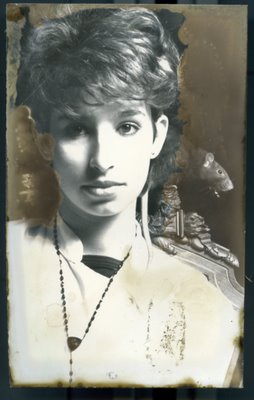
In early 1985 Vancouver Magazine was working on a story on the new but most uncertain coach of the Vancouver Canucks, Bill LaForge. I used to terrorize associate editor, Don Stanley by telling him, "LaForge was fired today, didn't you know?" Since the Vancouver Magazine story had not yet gone to press he would worry about what to do with the story. But it was my joke. As punishment I was dispatched to go to Edmonton to photograph LaForge. The Canucks were playing there one weekend and it would promise to be an interesting game as LaForge was a hometown boy while the Edmonton Oilers with Wayne Gretzky would surely give him a very hot homecoming. And that is exactly what happened.
When I showed up at the game my friend CBC sports cameraman Mike Varga whisked me by all the red tape and had me share his booth by the ice. The man sitting on the bench on the other side of my glass was Wayne Gretzky. During one of the intervals (the Canucks were losing miserably) Varga took me to the huge van were one man directed all the cameramen of Hockey Night In Canada. A wall of the van contained multiple TV screens. When the game was renewed (Varga left me in the van) I watched one of the most difficult and perhaps exciting jobs I have ever seen. The director would go from one screen to another and he always seemed to know who had the puck. The job seemed more stressful than being a air traffic controller. I was never able to see a hockey game again without appreciating the difficulty and the resulting expertise of the CBC sports staff. Mike Varga proudly told me, when I mentioned this, "We are the best in the world." I was not yet a Canadian citizen but I was proud.
In 1983 I had photographed an extremely beautiful singer, Madeleine Morris in her home on 16th and Granville. I had convinced Les Wiseman who hated synth-pop bands, to write about Morris's band Moev. Morris had a style, a presence and the juiciest mouth I had ever seen. She was tiny and with her short hair and dark but Jewish profile she resembled Nefertiti hooked on cigarettes. I photographed her (above) with her pet rat. Of the rat she told us, "The ordinary rat, the ordinary bubonic plague rat, makes a great pet because you don't have to take them out for walkies."
Before I left I was introduced to Morris's charming mother. She was lively and I could see where Madeleine had inherited her feisty talent. Since I have never really been a hockey fan it meant nothing when Morris explained that her mother, Dolores had composed the theme music for Hockey Night In Canada. I am a Canadian citizen now but I can affirm (boast perhaps?) that I never saw an entire episode of the Beachcombers and I would not recognize Dolores's composition if you played it with others.
But I am upset on how the CBC bungled their relationship with Dolores Claman. Without knowing all the details perhaps the CBC was right. But I was happy to hear that CTV has settled with Claman and that the theme song will not be lost.
The CBC from its headquarters in Toronto is using the Vancouver technique called slow irrelevance. Witness how the Dal Grauer Substation on Burrard (next to what used to be called the BC Electric, then the BC Hydro and now the Electra building) is being slowly abandoned so that it will become invisible. When the wrecking balls come nobody will notice or care about this Vancouver architectural gem. The same happend to the Georgia Medical Dental Building, the original Eatons, and the second Vancouver Hotel. They all went down with almost no protest.
First take away the name of Vancouver from the CBC Vancouver Orchestra. Make it the national CBC Radio Orchestra. Then as a fate accompli inform us, the taxpayers, that the orchestra will be no more after November. For me many of the oldsters on CBC Radio 1 and 2 sounded a bit old, tired and bored. But at least they had attractive and gentle or calming voices. In spite of Shelagh Rogers's loudish laugh she does have a wonderful voice. Even her voice (or her mothers' who had an even better voice) could do no justice or impart any poetry to her replacement's name.
These oldsters have been replaced by people with fairly unattractive voices and I find it impossible to spell or pronounce their names. I suspect this is a conservative-getting-old rant on my part!
But I used to listen to Katherine Duncan's late night program on Radio 2,
"This is Katherine Duncan from Calgary," she would say with a magical voice that almost wanted me to inform wife Rosemary, "I divorce you, here and now, and I am off to romantic and exotic Calgary." Such was the power of Duncan's voice that she made Calgary seem like that exotic destination.
Another voice (erudite, too) was Peter Tonye's. While these two will be back on the radio I see the Vancouver irrelevance technique well at play. We oldsters (I am 65) just simply turn of the radio and listen to CDs in the car. I am not sure if the younger generation is all that excited about Grant Lawrence's podcasts or banal programs about what women will be wearing in the street next season. As the CBC sounds more and more like commercial radio, it will fade with the fortunes of other commercial radio stations. Commercial radio has ads. CBC Radio 1 has constant Jian Gomeshi ads. Is there a difference?
For me CBC radio has stood out with its uniqueness and not being part of the crowd. When the CBC finally goes off the air I will not care. Will others? Just this once I wish that Toronto had not learned Vancouver's irrelevance trick so quickly and so well.
The other side of the story?
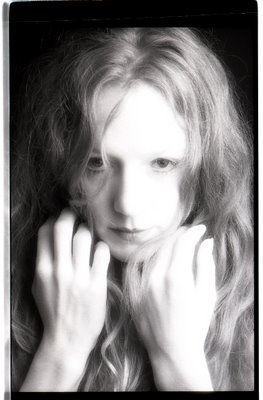
There is a neat little book in my library (printed in 1968) that I look at and read in sections every once in a while. It is a book about a vanishing era of photography. The subject is and was called the Zone System. The man who pioneered most of it was Ansel Adams but the man who wrote about it in a Zen kind of way was the American Photographer and teacher Minor White. Minor White's little book is called Zone System Manual - Previsualization - Exposure - Development - Printing.
Minor White's idea was that you could approach a scene and take a photograph with your mind's eye. If you were really good at it and you had the technical practice then the image in your mind would be realized with camera and film. This was the photographic equivalent of the architect who sees an empty space and can already see the finished building before the cornerstone is laid.
This act of previsualization comes to me infrequently. When it happens it is sheer joy. Sometimes my subject will pose. I will shoot a Polaroid and then a couple of pictures with film and stop. At one time I would take rolls and rolls of film. But in these rare moments one exposure is all I need. I know that the image in my head will be exactly the one on film. Of course the chances of this happening are greater when I reduce the variables such as doing it in my studio, using a specific light I am comfortable with and using a tried and true technique.
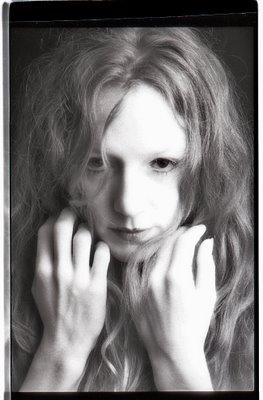
You would think that this predictability could be boring in the end. Consider what Minor White says in his introduction:
The ultimate objective is to be able to previsualize as one wishes, spontaneously or leisurely whichever best serves the purposes at hand. There is a difference in the penetrating power of an image made in a burst of naive enthusiasm and those made in a flash of trained intuition. The first is adolescent, the latter mature and sometimes wise.
Minor White then eloquently writes on the subject of previsualization and the development of intuition:
Photography serves all kinds of image-making talent in mankind wiht an equality that almost amounts to an holy indifference. It does not distinguish the sleeper from the trancendentalist; it serves the first with its automatic mechanicalness, the second with its power to evoke th sense of light in images. It gives the spark of creativity in anyone a fine chance to grow. And from those people who have grown to love photography and master it have come three psychological concepts: Equivalence (Alfred Stieglitz), Previsualization (Edward Weston and Ansel Adams) and Response. )( The latter sometimes goes under the name of "reading photographs".) These concepts give affirmation to individuals who pursue consciousness and wakefulness by way of photography.
Forty years ago a Mexican chemical engineer, radio station owner and amateur photographer, Ingeniero Luis de la Rosa took me under his wing and revealed to me The Zone System. We photographers who have at the very least a minimum understanding of it (that's me) will always capitalize it (The Zone System!) on principle. It was de la Rosa who taught me to use a hand held light meter in the incidence mode (measuring the light that falls on the scene) as opposed to the usually innacurate reflected mode (it measures light bouncing off from our scene).
One day, I remember it so vividly that I know we were having coffee in the Sanborns on Calle Amberes in Mexico City, de la Rosa handed me a yellow box of Kodak b+w infrared film. His instructions were as follows:
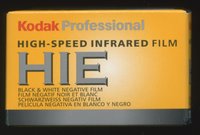
1. Don't open the container except in absolute darkness.
2. Load it into your camera in absolute darkness.
3. Expose it using a No 25 deep red filter.
4. Infra red light focuses at a different wave length so when you focus with your lens then "unfocus" to the little red mark on your lens's focusing ring.
5. Remove the film only in darkness.
6. Develop it in Kodak HC-110. If this developer was good enough for Ansel Adams it should be good enough for you.
Of course I didn't follow the man's advice and I opened the container during the day. Light slipped in and fogged the film. I had to start again. But once I had gotten the hang of it I was rewarded by exposures that were not always predictable. And every once in a while serendipity gave me completely unplanned yet wonderful shots. Infra red film is a grainy film which reacts to objects, plants and people in how much infrared light they reflect. Decidious tree leaves will photograph a startling white. Blue skies and white clouds will look like a b+w Randolph Scott western, nuit américaine, day for night.
But it is in shooting nudes and portraits that infrared film becomes a constant and almost unpredictable surprise. I am sure that Minor White might have modified his little book to include infrared film. He had that mystical connections. We mortals simply have to adjust to its randomness. It was infrared film that made Lauri Stallings look like she was jumping in the air when she was really sitting on a stool.
One predictable result of using infrared film is that anything red always appears much lighter or white. This means that lips in portraits appear white and my subjects might look dead, or worse, undead. The solution is to use purple lipstick. Since purple is in the opposite end of colour spectrum it renders dark. I have been looked at strangely at London Drugs the times I have gone to the makeup counter to ask for purple lipstick.
The single most unpredictable variable in using infrared film is the way that my flashe's catchlights might not appear reflected on my subject's eyes. It seems to depend on certain angles (the angle between the light and the elevation of the eyes) that only de la Rosa might have explained to me. As example I show here one exposure of Lauri Stallings scanned in three different ways. The images range from angel to witch. Of course infrared film renders Stallings's hair as near white. In this third version I colourized to increase the idea of the witch and to remove it as far from the first image of the angel.
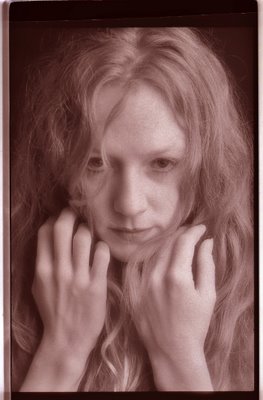
Kodak recently discontinued its infrared film. I have a few boxes in my freezer. Then I discovered that my Corel Paint Shop Pro X photo program has an uncanny conversion of b+w to b+w infrared. It is so good that it manages to look more like infrared film than authentic infrared film. You are now able to previsualize a scene or portrait and get what's in your mind every time.
At least that's what I thought. But notice in the above three photographs the curious look in Stallings's eyes. Then look at the picture below (left) which is standard b+w and then a Corel Paint Shop Pro X modified to look like infrared (below, right). There is something missing in the eyes.
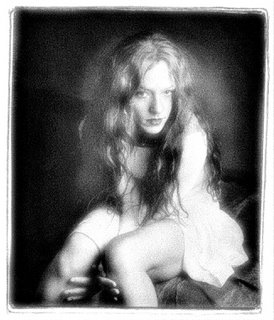
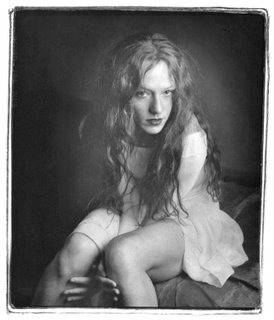
Compare those two (I am satisfied with the normal b+w version on the left) with the true infrared below. I think that while previsualization is a good thing it is so much fun to be surprised!
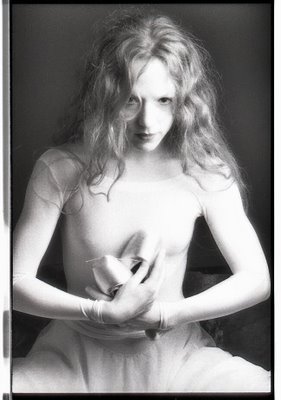

When we arrived to Vancouver so long ago I told Rosemary I was going to teach myself to print colour negatives. I procrastinated for so long a time that one day Rosemary said, "Alex I have taken the libery of enrolling you at Ampro Photo Workshops for a course in colour printing. You begin this Monday." And so I learned to print colour negatives, sort of. I thought I was pretty good until I photographed a red haired stewardess (in 1976 this was the only accepted term for the profession) who wanted pleasant portraits of herself. I photographed her in her garden. That's when the problem began. The grass and the nearby trees reflected green on her face.

When I tried to remove green from her face in my darkroom the resulting prints were too magenta. If I removed magenta (by adding magenta, colour printing can be confusing!) the resulting prints were too green. After four days and lots of wasted paper I gave up. I made the best prints I could. She was happy.
I was too "green" in the profession of colour photography to understand what few perhaps even understand today. The skin of a redhaired person reflects UV light differently from the skin of most other people. That whiteness (which I find so appealing) of their skin can really only be "captured" (to use the modern parlance of digital photography) with a good digital camera. The photographer, a competent one, is able to achieve through something called a custom white or proper white balance a skin tone that is as accurate as one's memory of what a person's skin should look like. And this specially applies to redheads.

I have been most jealous of the skin colour that my students achive in my classes (in the studio sessions) of our models. It looks accurate. It has the look of skin that only one photographer of the past was able to secure. It was, Paul Outerbridge, an American photographer of the 30s (through the 50s) who using an elaborate process called the colour carbro achieved prints of nude women in which their skin looked real.

I had a further opportunity to excercise my futility with redheads. The resulting problem was an Ekatchrome transparency problem. When I photograph people in my studio I usually do it with my middle gray painted wall. Ektachrome has always rendered the gray wall with anything from a slightly blue to a very blue tone of gray. When I scan these transparencies and remove the blueness it adds yellow. Yellow makes the skin of a red head innacurate. Only a digital camera will properly render that gray background gray and the skin as it is.

While I may have failed at achieving the true skin colour of the readhead (perhaps one of the Holy Grails of photography!) I did take some photographs of Lauri Stallings that I think are stunning. Not stunning because of any special talent that I might have. Stunning because Stallings truly delivered when I asked her to pose for me and give me her take on the dancer with an edge. The scans you see here are from Ektachromes. I also shot them with colour negative but I don't think I will ever go into my darkroom to print those. That stewardess would come back to haunt me.

But then when I scanned these yesterday I was haunted again by the formidable presence of Lauri Stallings. Will I ever meet anybody like her again? And if I did would she pose for me?
Entropy and the Second Law of Thermodynamics
The second law of thermodynamics (the entropy law or law of entropy) was formulated in the middle of the last century by Clausius and Thomson following Carnot's earlier observation that, like the fall or flow of a stream that turns a mill wheel, it is the "fall" or flow of heat from higher to lower temperatures that motivates a steam engine. The key insight was that the world is inherently active, and that whenever an energy distribution is out of equilibrium a potential or thermodynamic "force" (the gradient of a potential) exists that the world acts spontaneously to dissipate or minimize. All real-world change or dynamics is seen to follow, or be motivated, by this law.
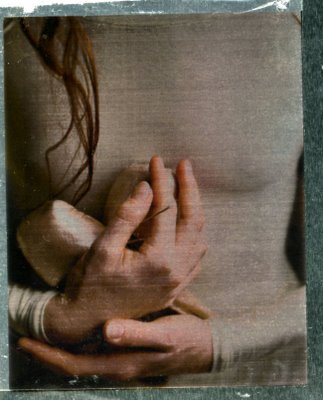
My friend Ian McGuffie often talks about entropy and how everything disipates, slows down and comes to a grinding halt. Perhaps he is right on all of it but most recently in the science section of the NY Times in an article called Dark, Perhaps Forever I learn that at the outer reaches of our universe everything is expanding at an ever increasing rate. There seems to be no chance that entropy is involved.
Entropy affect us all, particularly when factor age and how our body forces us to slow down. Then there is laziness and the ease of sitting down at a computer and how much for fun it is than to jog around the block 37 times. My friend Les Wiseman used to advise me, " Drink, and when in doubt do so heavily." In youth quantity is quality. In our declining age we (or at least this blogger) believe is quality is doing something well in moderation. By now some of you must be wondering (perhaps its your youth!), "Get on with it and show us more of Lauri Stallings. What does entropy have to do with her?"

Those who have no idea of digital cameras can skip this paragraph. A digital camera gives you the choice of shooting RAW or jpgs. Both are formats for storing and reproducing digital captures. A negative or slide is exposed to light. A latent image is then embedded and has to be process or developed to see it. With digital cameras the operation of light falling on the sensor (not film) is called digital capture. Very fancy DSLRs (Digital Single Lens Reflex cameras) give their owners not only the choice of shooting RAW or in the much smaller digital file called the jpg but also in modes such as infrared, b+w, etc. Cautious photographers tend to shoot with huge files called RAW. Everything the camera does is recorded and stored in these files. In some cases even the exact spot on earth using GPS (global positioning systems by satellite use). If the photographer makes exposure mistakes RAW files allow more leeway for correction than the more limited jpg. Few photographers will commit themselves to shooting in a dedicated b+w mode. Suppose the client wants the images in colour? What then? So they cover all the bases and shoot RAW. Then they spend long hours sifting, correcting, editing.
My solution in the stone age of film was to shoot with everything I had. And here comes the connection with Lauri Stallings.
I so loved shooting Stallings that I persuaded to explore the theme of the ballerina that is not a swan but a real woman. Dancing was supposed to be effortless and ethereal. We were out to show that there was lots of eros, too.
With my Mamiya RB-67 which shoots film in the 6x7cm format I had the option of using several film backs. This meant that I loaded one back with Ektachrome transparency, one with Kodacolour negative film and the third with b+w negative film. If this was not enought I also shot with a Nikon FM-2 loaded with Kodak b+w infrared film which alas, has now been discontinued.
Every picture I took of Stallings I have reproduced in all four methods. Perhas when she looked at my camera with Ektachrome, her expression was better than with the colour negative. It did not matter because Stallings was very good at keeping her expressions, or perhaps in remembering them and being able to repeat them.
For a show, so many years ago at Ian McGuffie's Exposure Gallery I dedicated my entries to Stallings. The transparencies were converted to digital files and then some low resolution Canon Fiery transparencies (they had a curious varnish like finish) were generated by my friend Grant Simmons at DISC. These I mounted on silver card. In the gallery, with overhead lighting, they shimmered like colour Daguerrotypes.
The colour negatives I had converted to a see-through Kodak material called Duratrans and I also mounted these on silver card. They shimmered, too and the detail was astounding. The Canon Fieries were more interesting.
The first image here is an example of a Canon Fiery. It does not shimmer because I could only reproduce it by laying it on my scanner. The second one, also in colour, is Grant's original jpg file (on a floppy!) that he used to make the four different images of Stallings acting out a not quite so pristine and innocent ballerina.
The images in yesterday's blog are each an example of b+w. The one of Stallings jumping (She is not! She was sitting on a stool) I used infrared film. The other is the 6x7 format b+w. The b+w contact sheet shows some pictures (one the left side of the contact sheet, more tomorrow) of a curious coreographed performance that Stallings did for my camera. It was her version of the ballerina exploring and inner self I had no idea of. Since then I have found out that the extremely original Stallings is in high demand in the US as a choreographer. Who would have known that the pristine ballerina in the long white dress, backstage at the Queen Elizabeth was the same woman?
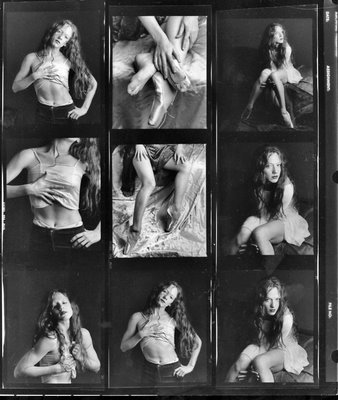
Recently I told Rebecca that we did not have to leave so early to go to a performance of Peter Bingham and Emily Molnar at EDAM. I told her that EDAM is very small and every seat is a good one. Rebecca repeated what she has often heard from me, "I want to go early because I want to sit on the front row and listen to the dancers breathe." It was from Stallings that I first caught a glimpse of this humanity. I have been enthralled since, even if entropy has made me slow down, somewhat. Perhaps what I need is another (could that be possible?) Lauri Stallings to push me to the edges of my known universe where entropy has no domain and excitement is everything speeded up.

In early 1985 Vancouver Magazine was working on a story on the new but most uncertain coach of the Vancouver Canucks, Bill LaForge. I used to terrorize associate editor, Don Stanley by telling him, "LaForge was fired today, didn't you know?" Since the Vancouver Magazine story had not yet gone to press he would worry about what to do with the story. But it was my joke. As punishment I was dispatched to go to Edmonton to photograph LaForge. The Canucks were playing there one weekend and it would promise to be an interesting game as LaForge was a hometown boy while the Edmonton Oilers with Wayne Gretzky would surely give him a very hot homecoming. And that is exactly what happened.
When I showed up at the game my friend CBC sports cameraman Mike Varga whisked me by all the red tape and had me share his booth by the ice. The man sitting on the bench on the other side of my glass was Wayne Gretzky. During one of the intervals (the Canucks were losing miserably) Varga took me to the huge van were one man directed all the cameramen of Hockey Night In Canada. A wall of the van contained multiple TV screens. When the game was renewed (Varga left me in the van) I watched one of the most difficult and perhaps exciting jobs I have ever seen. The director would go from one screen to another and he always seemed to know who had the puck. The job seemed more stressful than being a air traffic controller. I was never able to see a hockey game again without appreciating the difficulty and the resulting expertise of the CBC sports staff. Mike Varga proudly told me, when I mentioned this, "We are the best in the world." I was not yet a Canadian citizen but I was proud.
In 1983 I had photographed an extremely beautiful singer, Madeleine Morris in her home on 16th and Granville. I had convinced Les Wiseman who hated synth-pop bands, to write about Morris's band Moev. Morris had a style, a presence and the juiciest mouth I had ever seen. She was tiny and with her short hair and dark but Jewish profile she resembled Nefertiti hooked on cigarettes. I photographed her (above) with her pet rat. Of the rat she told us, "The ordinary rat, the ordinary bubonic plague rat, makes a great pet because you don't have to take them out for walkies."
Before I left I was introduced to Morris's charming mother. She was lively and I could see where Madeleine had inherited her feisty talent. Since I have never really been a hockey fan it meant nothing when Morris explained that her mother, Dolores had composed the theme music for Hockey Night In Canada. I am a Canadian citizen now but I can affirm (boast perhaps?) that I never saw an entire episode of the Beachcombers and I would not recognize Dolores's composition if you played it with others.
But I am upset on how the CBC bungled their relationship with Dolores Claman. Without knowing all the details perhaps the CBC was right. But I was happy to hear that CTV has settled with Claman and that the theme song will not be lost.
The CBC from its headquarters in Toronto is using the Vancouver technique called slow irrelevance. Witness how the Dal Grauer Substation on Burrard (next to what used to be called the BC Electric, then the BC Hydro and now the Electra building) is being slowly abandoned so that it will become invisible. When the wrecking balls come nobody will notice or care about this Vancouver architectural gem. The same happend to the Georgia Medical Dental Building, the original Eatons, and the second Vancouver Hotel. They all went down with almost no protest.
First take away the name of Vancouver from the CBC Vancouver Orchestra. Make it the national CBC Radio Orchestra. Then as a fate accompli inform us, the taxpayers, that the orchestra will be no more after November. For me many of the oldsters on CBC Radio 1 and 2 sounded a bit old, tired and bored. But at least they had attractive and gentle or calming voices. In spite of Shelagh Rogers's loudish laugh she does have a wonderful voice. Even her voice (or her mothers' who had an even better voice) could do no justice or impart any poetry to her replacement's name.
These oldsters have been replaced by people with fairly unattractive voices and I find it impossible to spell or pronounce their names. I suspect this is a conservative-getting-old rant on my part!
But I used to listen to Katherine Duncan's late night program on Radio 2,
"This is Katherine Duncan from Calgary," she would say with a magical voice that almost wanted me to inform wife Rosemary, "I divorce you, here and now, and I am off to romantic and exotic Calgary." Such was the power of Duncan's voice that she made Calgary seem like that exotic destination.
Another voice (erudite, too) was Peter Tonye's. While these two will be back on the radio I see the Vancouver irrelevance technique well at play. We oldsters (I am 65) just simply turn of the radio and listen to CDs in the car. I am not sure if the younger generation is all that excited about Grant Lawrence's podcasts or banal programs about what women will be wearing in the street next season. As the CBC sounds more and more like commercial radio, it will fade with the fortunes of other commercial radio stations. Commercial radio has ads. CBC Radio 1 has constant Jian Gomeshi ads. Is there a difference?
For me CBC radio has stood out with its uniqueness and not being part of the crowd. When the CBC finally goes off the air I will not care. Will others? Just this once I wish that Toronto had not learned Vancouver's irrelevance trick so quickly and so well.
The other side of the story?
Previsualizing The Unpredictable - Minor White
Tuesday, June 10, 2008

There is a neat little book in my library (printed in 1968) that I look at and read in sections every once in a while. It is a book about a vanishing era of photography. The subject is and was called the Zone System. The man who pioneered most of it was Ansel Adams but the man who wrote about it in a Zen kind of way was the American Photographer and teacher Minor White. Minor White's little book is called Zone System Manual - Previsualization - Exposure - Development - Printing.
Minor White's idea was that you could approach a scene and take a photograph with your mind's eye. If you were really good at it and you had the technical practice then the image in your mind would be realized with camera and film. This was the photographic equivalent of the architect who sees an empty space and can already see the finished building before the cornerstone is laid.
This act of previsualization comes to me infrequently. When it happens it is sheer joy. Sometimes my subject will pose. I will shoot a Polaroid and then a couple of pictures with film and stop. At one time I would take rolls and rolls of film. But in these rare moments one exposure is all I need. I know that the image in my head will be exactly the one on film. Of course the chances of this happening are greater when I reduce the variables such as doing it in my studio, using a specific light I am comfortable with and using a tried and true technique.

You would think that this predictability could be boring in the end. Consider what Minor White says in his introduction:
The ultimate objective is to be able to previsualize as one wishes, spontaneously or leisurely whichever best serves the purposes at hand. There is a difference in the penetrating power of an image made in a burst of naive enthusiasm and those made in a flash of trained intuition. The first is adolescent, the latter mature and sometimes wise.
Minor White then eloquently writes on the subject of previsualization and the development of intuition:
Photography serves all kinds of image-making talent in mankind wiht an equality that almost amounts to an holy indifference. It does not distinguish the sleeper from the trancendentalist; it serves the first with its automatic mechanicalness, the second with its power to evoke th sense of light in images. It gives the spark of creativity in anyone a fine chance to grow. And from those people who have grown to love photography and master it have come three psychological concepts: Equivalence (Alfred Stieglitz), Previsualization (Edward Weston and Ansel Adams) and Response. )( The latter sometimes goes under the name of "reading photographs".) These concepts give affirmation to individuals who pursue consciousness and wakefulness by way of photography.
Forty years ago a Mexican chemical engineer, radio station owner and amateur photographer, Ingeniero Luis de la Rosa took me under his wing and revealed to me The Zone System. We photographers who have at the very least a minimum understanding of it (that's me) will always capitalize it (The Zone System!) on principle. It was de la Rosa who taught me to use a hand held light meter in the incidence mode (measuring the light that falls on the scene) as opposed to the usually innacurate reflected mode (it measures light bouncing off from our scene).
One day, I remember it so vividly that I know we were having coffee in the Sanborns on Calle Amberes in Mexico City, de la Rosa handed me a yellow box of Kodak b+w infrared film. His instructions were as follows:

1. Don't open the container except in absolute darkness.
2. Load it into your camera in absolute darkness.
3. Expose it using a No 25 deep red filter.
4. Infra red light focuses at a different wave length so when you focus with your lens then "unfocus" to the little red mark on your lens's focusing ring.
5. Remove the film only in darkness.
6. Develop it in Kodak HC-110. If this developer was good enough for Ansel Adams it should be good enough for you.
Of course I didn't follow the man's advice and I opened the container during the day. Light slipped in and fogged the film. I had to start again. But once I had gotten the hang of it I was rewarded by exposures that were not always predictable. And every once in a while serendipity gave me completely unplanned yet wonderful shots. Infra red film is a grainy film which reacts to objects, plants and people in how much infrared light they reflect. Decidious tree leaves will photograph a startling white. Blue skies and white clouds will look like a b+w Randolph Scott western, nuit américaine, day for night.
But it is in shooting nudes and portraits that infrared film becomes a constant and almost unpredictable surprise. I am sure that Minor White might have modified his little book to include infrared film. He had that mystical connections. We mortals simply have to adjust to its randomness. It was infrared film that made Lauri Stallings look like she was jumping in the air when she was really sitting on a stool.
One predictable result of using infrared film is that anything red always appears much lighter or white. This means that lips in portraits appear white and my subjects might look dead, or worse, undead. The solution is to use purple lipstick. Since purple is in the opposite end of colour spectrum it renders dark. I have been looked at strangely at London Drugs the times I have gone to the makeup counter to ask for purple lipstick.
The single most unpredictable variable in using infrared film is the way that my flashe's catchlights might not appear reflected on my subject's eyes. It seems to depend on certain angles (the angle between the light and the elevation of the eyes) that only de la Rosa might have explained to me. As example I show here one exposure of Lauri Stallings scanned in three different ways. The images range from angel to witch. Of course infrared film renders Stallings's hair as near white. In this third version I colourized to increase the idea of the witch and to remove it as far from the first image of the angel.

Kodak recently discontinued its infrared film. I have a few boxes in my freezer. Then I discovered that my Corel Paint Shop Pro X photo program has an uncanny conversion of b+w to b+w infrared. It is so good that it manages to look more like infrared film than authentic infrared film. You are now able to previsualize a scene or portrait and get what's in your mind every time.
At least that's what I thought. But notice in the above three photographs the curious look in Stallings's eyes. Then look at the picture below (left) which is standard b+w and then a Corel Paint Shop Pro X modified to look like infrared (below, right). There is something missing in the eyes.


Compare those two (I am satisfied with the normal b+w version on the left) with the true infrared below. I think that while previsualization is a good thing it is so much fun to be surprised!

Lauri Stallings - A Swan Song - Perhaps
Monday, June 09, 2008

When we arrived to Vancouver so long ago I told Rosemary I was going to teach myself to print colour negatives. I procrastinated for so long a time that one day Rosemary said, "Alex I have taken the libery of enrolling you at Ampro Photo Workshops for a course in colour printing. You begin this Monday." And so I learned to print colour negatives, sort of. I thought I was pretty good until I photographed a red haired stewardess (in 1976 this was the only accepted term for the profession) who wanted pleasant portraits of herself. I photographed her in her garden. That's when the problem began. The grass and the nearby trees reflected green on her face.

When I tried to remove green from her face in my darkroom the resulting prints were too magenta. If I removed magenta (by adding magenta, colour printing can be confusing!) the resulting prints were too green. After four days and lots of wasted paper I gave up. I made the best prints I could. She was happy.
I was too "green" in the profession of colour photography to understand what few perhaps even understand today. The skin of a redhaired person reflects UV light differently from the skin of most other people. That whiteness (which I find so appealing) of their skin can really only be "captured" (to use the modern parlance of digital photography) with a good digital camera. The photographer, a competent one, is able to achieve through something called a custom white or proper white balance a skin tone that is as accurate as one's memory of what a person's skin should look like. And this specially applies to redheads.

I have been most jealous of the skin colour that my students achive in my classes (in the studio sessions) of our models. It looks accurate. It has the look of skin that only one photographer of the past was able to secure. It was, Paul Outerbridge, an American photographer of the 30s (through the 50s) who using an elaborate process called the colour carbro achieved prints of nude women in which their skin looked real.

I had a further opportunity to excercise my futility with redheads. The resulting problem was an Ekatchrome transparency problem. When I photograph people in my studio I usually do it with my middle gray painted wall. Ektachrome has always rendered the gray wall with anything from a slightly blue to a very blue tone of gray. When I scan these transparencies and remove the blueness it adds yellow. Yellow makes the skin of a red head innacurate. Only a digital camera will properly render that gray background gray and the skin as it is.

While I may have failed at achieving the true skin colour of the readhead (perhaps one of the Holy Grails of photography!) I did take some photographs of Lauri Stallings that I think are stunning. Not stunning because of any special talent that I might have. Stunning because Stallings truly delivered when I asked her to pose for me and give me her take on the dancer with an edge. The scans you see here are from Ektachromes. I also shot them with colour negative but I don't think I will ever go into my darkroom to print those. That stewardess would come back to haunt me.

But then when I scanned these yesterday I was haunted again by the formidable presence of Lauri Stallings. Will I ever meet anybody like her again? And if I did would she pose for me?
Stallings Entropy
Sunday, June 08, 2008
Entropy and the Second Law of Thermodynamics
The second law of thermodynamics (the entropy law or law of entropy) was formulated in the middle of the last century by Clausius and Thomson following Carnot's earlier observation that, like the fall or flow of a stream that turns a mill wheel, it is the "fall" or flow of heat from higher to lower temperatures that motivates a steam engine. The key insight was that the world is inherently active, and that whenever an energy distribution is out of equilibrium a potential or thermodynamic "force" (the gradient of a potential) exists that the world acts spontaneously to dissipate or minimize. All real-world change or dynamics is seen to follow, or be motivated, by this law.

My friend Ian McGuffie often talks about entropy and how everything disipates, slows down and comes to a grinding halt. Perhaps he is right on all of it but most recently in the science section of the NY Times in an article called Dark, Perhaps Forever I learn that at the outer reaches of our universe everything is expanding at an ever increasing rate. There seems to be no chance that entropy is involved.
Entropy affect us all, particularly when factor age and how our body forces us to slow down. Then there is laziness and the ease of sitting down at a computer and how much for fun it is than to jog around the block 37 times. My friend Les Wiseman used to advise me, " Drink, and when in doubt do so heavily." In youth quantity is quality. In our declining age we (or at least this blogger) believe is quality is doing something well in moderation. By now some of you must be wondering (perhaps its your youth!), "Get on with it and show us more of Lauri Stallings. What does entropy have to do with her?"

Those who have no idea of digital cameras can skip this paragraph. A digital camera gives you the choice of shooting RAW or jpgs. Both are formats for storing and reproducing digital captures. A negative or slide is exposed to light. A latent image is then embedded and has to be process or developed to see it. With digital cameras the operation of light falling on the sensor (not film) is called digital capture. Very fancy DSLRs (Digital Single Lens Reflex cameras) give their owners not only the choice of shooting RAW or in the much smaller digital file called the jpg but also in modes such as infrared, b+w, etc. Cautious photographers tend to shoot with huge files called RAW. Everything the camera does is recorded and stored in these files. In some cases even the exact spot on earth using GPS (global positioning systems by satellite use). If the photographer makes exposure mistakes RAW files allow more leeway for correction than the more limited jpg. Few photographers will commit themselves to shooting in a dedicated b+w mode. Suppose the client wants the images in colour? What then? So they cover all the bases and shoot RAW. Then they spend long hours sifting, correcting, editing.
My solution in the stone age of film was to shoot with everything I had. And here comes the connection with Lauri Stallings.
I so loved shooting Stallings that I persuaded to explore the theme of the ballerina that is not a swan but a real woman. Dancing was supposed to be effortless and ethereal. We were out to show that there was lots of eros, too.
With my Mamiya RB-67 which shoots film in the 6x7cm format I had the option of using several film backs. This meant that I loaded one back with Ektachrome transparency, one with Kodacolour negative film and the third with b+w negative film. If this was not enought I also shot with a Nikon FM-2 loaded with Kodak b+w infrared film which alas, has now been discontinued.
Every picture I took of Stallings I have reproduced in all four methods. Perhas when she looked at my camera with Ektachrome, her expression was better than with the colour negative. It did not matter because Stallings was very good at keeping her expressions, or perhaps in remembering them and being able to repeat them.
For a show, so many years ago at Ian McGuffie's Exposure Gallery I dedicated my entries to Stallings. The transparencies were converted to digital files and then some low resolution Canon Fiery transparencies (they had a curious varnish like finish) were generated by my friend Grant Simmons at DISC. These I mounted on silver card. In the gallery, with overhead lighting, they shimmered like colour Daguerrotypes.
The colour negatives I had converted to a see-through Kodak material called Duratrans and I also mounted these on silver card. They shimmered, too and the detail was astounding. The Canon Fieries were more interesting.
The first image here is an example of a Canon Fiery. It does not shimmer because I could only reproduce it by laying it on my scanner. The second one, also in colour, is Grant's original jpg file (on a floppy!) that he used to make the four different images of Stallings acting out a not quite so pristine and innocent ballerina.
The images in yesterday's blog are each an example of b+w. The one of Stallings jumping (She is not! She was sitting on a stool) I used infrared film. The other is the 6x7 format b+w. The b+w contact sheet shows some pictures (one the left side of the contact sheet, more tomorrow) of a curious coreographed performance that Stallings did for my camera. It was her version of the ballerina exploring and inner self I had no idea of. Since then I have found out that the extremely original Stallings is in high demand in the US as a choreographer. Who would have known that the pristine ballerina in the long white dress, backstage at the Queen Elizabeth was the same woman?

Recently I told Rebecca that we did not have to leave so early to go to a performance of Peter Bingham and Emily Molnar at EDAM. I told her that EDAM is very small and every seat is a good one. Rebecca repeated what she has often heard from me, "I want to go early because I want to sit on the front row and listen to the dancers breathe." It was from Stallings that I first caught a glimpse of this humanity. I have been enthralled since, even if entropy has made me slow down, somewhat. Perhaps what I need is another (could that be possible?) Lauri Stallings to push me to the edges of my known universe where entropy has no domain and excitement is everything speeded up.
Saturday, June 07, 2008
Sukie was the last to leave Eastwick; the afterimage of her in her nappy suede skirt and orange hair, swinging her long legs and arms past the glinting shopfronts, lingered on Dock Street like the cool-colored ghost the eye retains after staring as something bright. This was years ago. The young harbormaster with whom she had her last affair has a paunch now, and three children; but he still remembers how she used to bite his shoulder and say she loved the taste the salt of the sea-mist condensed on his skin.
The Witches of Eastwick - John Updike 1984
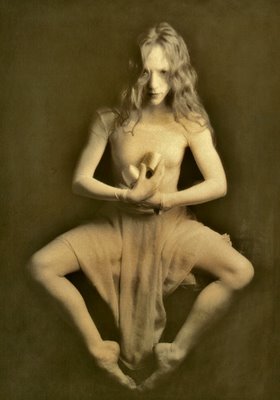
I have been looking at my Lauri Stallings file. It is full of images that are some of the most striking I have ever taken. Some years ago when I was doing a fashion spread for the Georgia Straight with Ballet BC dancers in the Marble Arch I was amazed to see Lauri Stallings in a corner of an extra room Tony Ricci had given us so our subjects could change and relax between shooting sessions. There she was knitting and she smiled at me and in her Florida accent she said, "I knit, too."
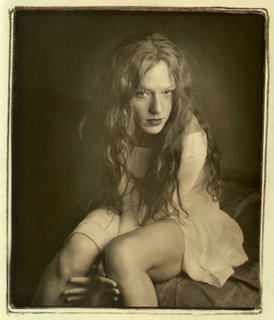
I thought, "Here is a witch with many talents."
Those who glance at this blog with some regularity can expect a few more days of Lauri Stallings.
Sukie was the last to leave Eastwick; the afterimage of her in her nappy suede skirt and orange hair, swinging her long legs and arms past the glinting shopfronts, lingered on Dock Street like the cool-colored ghost the eye retains after staring as something bright. This was years ago. The young harbormaster with whom she had her last affair has a paunch now, and three children; but he still remembers how she used to bite his shoulder and say she loved the taste the salt of the sea-mist condensed on his skin.
The Witches of Eastwick - John Updike 1984

I have been looking at my Lauri Stallings file. It is full of images that are some of the most striking I have ever taken. Some years ago when I was doing a fashion spread for the Georgia Straight with Ballet BC dancers in the Marble Arch I was amazed to see Lauri Stallings in a corner of an extra room Tony Ricci had given us so our subjects could change and relax between shooting sessions. There she was knitting and she smiled at me and in her Florida accent she said, "I knit, too."

I thought, "Here is a witch with many talents."
Those who glance at this blog with some regularity can expect a few more days of Lauri Stallings.
Friday, June 06, 2008
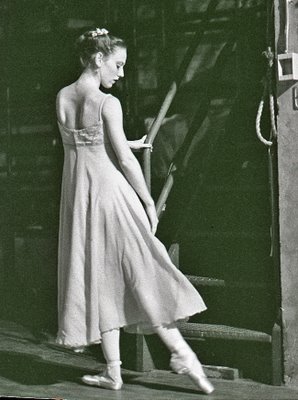
I always thought I had a good eye for beauty but it was only in 1995 when I met and photographed Evelyn Hart that I realized that I had made the motion of taking my daughters to ballet when they were young because as a father that was my duty. It took watching Evelyn Hart dance, and talk an even do nothing, for me to appreciate a whole aspect of beauty that I had missed most of my life. It was and is the beauty of dance.
Today I attended a two and a half hour performance of dance that was tediously mediocre. You have to try very hard to see mediocre dance in Vancouver. I didn't try, I simply had no choice.
When I got home I knew I had only about three hours to keep my promise to write a blog every day. How could I write about mediocrity? I had to write something. I have to write about something that will lift my spirit.
Shortly after meeting Evelyn Hart I knew I wanted to attend as many dance performances as I could. At the time, in 1995, Shannon Rupp and then Gail Johnson wrote almost weekly columns on dance for the Georgia Straight. This meant that I was assigned to take many dance photographs as the de facto dance photographer for the paper. I quickly decided that I could not compete with the local and national dance photographer of note, David Cooper who photographs dancers in the air in his studio. I made up my mind to pursue my interest in portraiture and use that angle to photograph dancers.
In the late 70s and 80s I had come to realize that shooting rock bands during concerts was a sure way of falling into a crowd of photographers who did that and that it was virtually impossible to take pictures that were original or different. The name of the game was access. But with a long lens access was not all that important. I used access and Vancouver Magazine's pull (Les Wiseman's In One Ear column was legendary so it gave the magazine credibility) to take photographs back stage. Here I could impose my own style. I would use lights and take portraits of the band members or lead singers in their dressing rooms. One portrait in particular gave me a small measure of fame. It was a photograph of Johnny Thunders
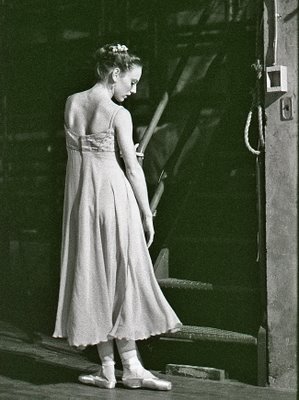
When I was given the opportunity of taking pictures back stage during a Ballet BC rehearsal I jumped. The experience was frustrating as the dancers looked in the direction of the would be audience so I got strange side shots. The lighting was minimal and I was using small cameras (not one of my fortes). It confirmed for me my vow of taking pictures of dancers only as portraits under controlled lighting conditions. And then I looked at the real back stage of the back stage. She was a read haired dancer I had never seen before.
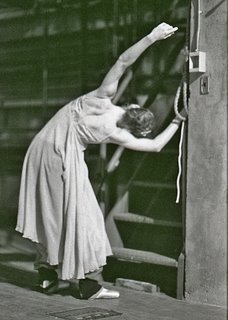
She was warming up. I was completely frozen in fascination and began to take some photographs. The photographs here of that dancer, Lauri Stallings do not do justice (for one thing they are not in colour) and you cannot discern her movements full of a grace I had never seen, nor seen since. Stallings had a style all her own. Just warming up she was perfection. A perfection that came from talent and training.
My mediocre dance experience of today has helped me at the very least to remember that perfection is there, even in the dark corners, if one is able to look for it. Perhaps too much perfection is not all that good.
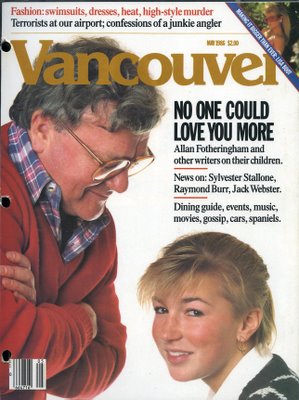
In 1952 I saw the film Scaramouche in Buenos Aires. My mother loved Stewart Granger and I was much too young to appreciate the charms of Eleanor Parker. I had nightmares that evening because the villain, played by Mel Ferrer was a terrific Noel, Marquis de Maynes. He had these intense cold eyes, and was a deadly effiecient sworsdman. To this day I remember that dialogue between Marquis de Maynes and Marie Antoinette (Nina Foch):
Marie Antoinette: I am angry with you, sir.
Noel, Marquis de Maynes: Angry, Your Majesty?
Marie Antoinette: Very angry! You know why, of course.
Noel, Marquis de Maynes: Could it be for fighting Count de Talles?
Marie Antoinette: Among others.
Noel, Marquis de Maynes: I only scratched him a little.
Marie Antoinette: They say you crippled him for life.
Marie Antoinette: And five minutes later,you killed the Baron Marblaux.
Noel, Marquis de Maynes: An unfortunate accident. He ran into my sword.
And who could possibly forget that super long and super fantastic fencing duel to the death) between Mel Ferrer and Stewart Granger?
In 1986 my Vancouver Magazine cover of Allan Fotheringham gazing on his daughter Francesca got me a Western Magazine Award for best magazine cover. The award came with a nice amount of cash. People asked me how I had come up with the idea. My answer, Bert Stern, always drew blanks.
Here is Bert Stern's cover of Audrey Hepburn and new husband (they had just gotten married in Paris) Mel Ferrer.
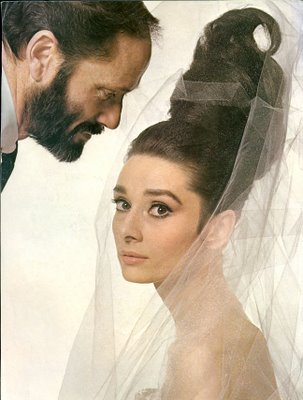
Mel Ferrer died yesterday at age 90. Just thinking of his role of Marquis de Maynes makes me shudder. Had I known then (1952) what I know now I would have shouted, "Don't kill him, Andre Moreau, he has to marry Audrey Hepburn one day." Only one person would have disagreed with me. Milady, played by Lana Turner in the Three Musketeers.

I always thought I had a good eye for beauty but it was only in 1995 when I met and photographed Evelyn Hart that I realized that I had made the motion of taking my daughters to ballet when they were young because as a father that was my duty. It took watching Evelyn Hart dance, and talk an even do nothing, for me to appreciate a whole aspect of beauty that I had missed most of my life. It was and is the beauty of dance.
Today I attended a two and a half hour performance of dance that was tediously mediocre. You have to try very hard to see mediocre dance in Vancouver. I didn't try, I simply had no choice.
When I got home I knew I had only about three hours to keep my promise to write a blog every day. How could I write about mediocrity? I had to write something. I have to write about something that will lift my spirit.
Shortly after meeting Evelyn Hart I knew I wanted to attend as many dance performances as I could. At the time, in 1995, Shannon Rupp and then Gail Johnson wrote almost weekly columns on dance for the Georgia Straight. This meant that I was assigned to take many dance photographs as the de facto dance photographer for the paper. I quickly decided that I could not compete with the local and national dance photographer of note, David Cooper who photographs dancers in the air in his studio. I made up my mind to pursue my interest in portraiture and use that angle to photograph dancers.
In the late 70s and 80s I had come to realize that shooting rock bands during concerts was a sure way of falling into a crowd of photographers who did that and that it was virtually impossible to take pictures that were original or different. The name of the game was access. But with a long lens access was not all that important. I used access and Vancouver Magazine's pull (Les Wiseman's In One Ear column was legendary so it gave the magazine credibility) to take photographs back stage. Here I could impose my own style. I would use lights and take portraits of the band members or lead singers in their dressing rooms. One portrait in particular gave me a small measure of fame. It was a photograph of Johnny Thunders

When I was given the opportunity of taking pictures back stage during a Ballet BC rehearsal I jumped. The experience was frustrating as the dancers looked in the direction of the would be audience so I got strange side shots. The lighting was minimal and I was using small cameras (not one of my fortes). It confirmed for me my vow of taking pictures of dancers only as portraits under controlled lighting conditions. And then I looked at the real back stage of the back stage. She was a read haired dancer I had never seen before.

She was warming up. I was completely frozen in fascination and began to take some photographs. The photographs here of that dancer, Lauri Stallings do not do justice (for one thing they are not in colour) and you cannot discern her movements full of a grace I had never seen, nor seen since. Stallings had a style all her own. Just warming up she was perfection. A perfection that came from talent and training.
My mediocre dance experience of today has helped me at the very least to remember that perfection is there, even in the dark corners, if one is able to look for it. Perhaps too much perfection is not all that good.
Melchior Gaston Ferrer aka Noel, Marquis de Maynes
Thursday, June 05, 2008

In 1952 I saw the film Scaramouche in Buenos Aires. My mother loved Stewart Granger and I was much too young to appreciate the charms of Eleanor Parker. I had nightmares that evening because the villain, played by Mel Ferrer was a terrific Noel, Marquis de Maynes. He had these intense cold eyes, and was a deadly effiecient sworsdman. To this day I remember that dialogue between Marquis de Maynes and Marie Antoinette (Nina Foch):
Marie Antoinette: I am angry with you, sir.
Noel, Marquis de Maynes: Angry, Your Majesty?
Marie Antoinette: Very angry! You know why, of course.
Noel, Marquis de Maynes: Could it be for fighting Count de Talles?
Marie Antoinette: Among others.
Noel, Marquis de Maynes: I only scratched him a little.
Marie Antoinette: They say you crippled him for life.
Marie Antoinette: And five minutes later,you killed the Baron Marblaux.
Noel, Marquis de Maynes: An unfortunate accident. He ran into my sword.
And who could possibly forget that super long and super fantastic fencing duel to the death) between Mel Ferrer and Stewart Granger?
In 1986 my Vancouver Magazine cover of Allan Fotheringham gazing on his daughter Francesca got me a Western Magazine Award for best magazine cover. The award came with a nice amount of cash. People asked me how I had come up with the idea. My answer, Bert Stern, always drew blanks.
Here is Bert Stern's cover of Audrey Hepburn and new husband (they had just gotten married in Paris) Mel Ferrer.

Mel Ferrer died yesterday at age 90. Just thinking of his role of Marquis de Maynes makes me shudder. Had I known then (1952) what I know now I would have shouted, "Don't kill him, Andre Moreau, he has to marry Audrey Hepburn one day." Only one person would have disagreed with me. Milady, played by Lana Turner in the Three Musketeers.
Wednesday, June 04, 2008
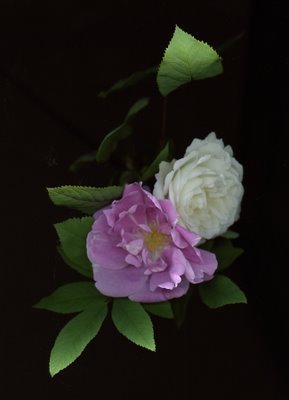
I must confess that in the almost 80 roses in my garden only one of them is a Canadian rose. It is Rosa 'Thérèse Bugnet'. She is usually the third rose (the first and second) to bloom in spring. Such was the case this year but she shared the honour with the English rose Rosa 'Fair Bianca' which happens to be my favourite rose of the garden because of her complex and special myrrh scent.
Thérèse Bugnet is a tall rose in our garden. She is 10ft high and one of her most attractive features is that the new canes are all wine red. The blooms are semi double, clear red, fading to pink and extremely fragrant. Because of its rugosa heritage (roses that originally came from Northern Japan, Korea and Siberia) she is hardy to Zone 2. This means she would grow just fine in Yellowknife.
And that would have been that and the only excuse for today's blag to post my scan of the two roses. I did the scan around three today. But I have always been curious about the name. Who was Thérèse Bugnet? My rose bible, Peter Beales - Classic Roses simply says:
Bugnet - Canada 1950.
Further enquiry led me to find out that Georges Bugnet had lived in Alberta and that he died at age 101. But he was far more complex and much more interesting than I could have imagined. The rose which was crossed from a Russian rose and an Alberta wild rose is 'Thérèse Bugnet'. Bugnet named the rose after his sister.
So here you have a Canadian rose bred by a Frenchman (in Northern Alberta) from a Russian rugosa next to an English rose named after the more placid sister of Shakespeare's shrew.
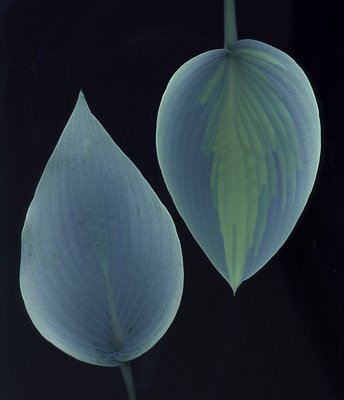
Monday was a sad day but an important one. Joan Hodgson, Donald Hodgson's widow, had indicated she wanted me to pass by to pick up a few hostas that I might want and to help her ID some that had no labels.
Sooner or later we must all got through the passage of deciding who gets what once we know we cannot part this world with any of it. Some may be lucky (are they?) to decide when they are alive, others may be unlucky (are they?) not to have to make that decision.
Donald Hodgson had converted (before he knew of his terminal cancer a year ago)after winding down his wholesale hosta business his backyard and front yard into a beautiful garden with winding paths, rare shrubs and trees, and hostas in clumps so large that made me salivate when I saw them.
Sadly he was not around to finish the garden and Joan had to get rid of some of the plants. At age 70 she must be able to handle the garden on her own.
The last time I had been in that garden Donald had given me a tour of the works while I waited for that moment when he would say, "Well Alex, which plants do you want to buy?" The price for his hostas which were tried and true specimens grown in large pots and kept for a few years before he would sell them, was far more reasonable than I could ever hope for. And Donald would always throw a few extra plants for nothing.
I remember one other day when I showed up with Rebecca and he said, "The best Hosta 'Halcyon' are the ones that come from Hosta 'June's that revert.
As I explained here about my fondness for the very blue Hosta 'Halcyon' becuase of its elegance and an ability to look good until late fall, my ears percked up. Donald and I both knew that the beautiful Hosta 'June' (below, left) was a spontaneous mutation of Halcyon in England.

When people come to my garden they invariably point at June and ask, "What is that?" or "Who is she?" While Halcyon is almost understated, June is quietly flamboyant. Donald was telling us that the best Halcyons where the ones that had been Halcyon at one time, become June, and then reverted or gone back to their roots. Donald gave Rebecca a pot of reverted June and when I saw it on Sunday afternoon at Rebecca's house I was breathless at its beauty and of leaves that did not have any spots. The plant is perfect. You can see some spots in the scan of the Halcyon leaf here (above, left, and the June leaf to its right).
Joan and I walked through the garden and when I would complain (when not being able to ID some plant,"Why is not Donald here to help?" Joan would say, "He is but I have yet to figure out how to communicate."
It was a sad afternoon and I told Joan and she understood when I mentioned, "This is going to happen to me some day. Perhaps over my roses, or my hostas or my negatives." Both of us understood that what we were doing was a sort of preparation for that final right of passage.
Before I left I went to one of the corners of Donald's garden and I pointed at a glorious plant (very much like the one below, in my garden) and I said, "Donald and I used to comment on how faithful, beautiful and ignored this ordinary hosta is. It is Hosta 'Antioch'".

As I look over this monitor on to the back garden I can spot Halcyon, June and Antioch. They are a piece of Donald in my garden. I will follow suit someday and be a piece in someone else's garden.

On our way back from Lillooet I took a barely noticeable side road after passing Boston Bar. Rosemary, Rebecca and Lauren looked at me strangely. "I have a surprise," I told them. I drove through a dense forest path and parked at the end. I noticed the patches of asphalt but did not reveal their origin to the girls. We crossed train tracks after we waited for the long train to pass. Then as we approached a clearing I told them, "Here is the surprise. See what is at the end of this path." The old Alexandra Bridge, the second one, according to friend Michael Kluckner ( who, alas, is now living in Australia whith his wife Christine Allen), appeared suddenly like a ghost in the blue light of the low cloud which was almost fog.
Some 10 years ago in circumstances that I do not fully recall, Malcolm Parry passed by the house one day and told me we were going on a ride. It was he who surprised me with the ghost at the end of the trail. I called him yesterday for details and all he could tell me was, "I took you there because that bridge has been very important in the history of our province." The patches of asphalt are what remeains in that are of the old Highway 1 Transcanada Highway.
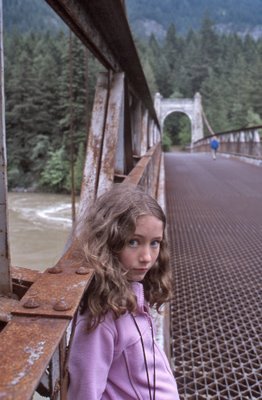
Some people might think that Malcolm Parry is a bit standoffish even when he is at his most charming. Few really know the man well. Yet I think I had the privilege of getting a few glimpses of the inner man in the close to 37 years that I have known him. And that day on the Alexandra Bridge was one of them.
Christine Allen
Christine Allen decamps for Australia
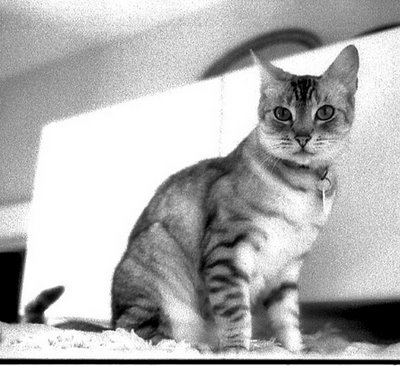
We returned this evening from a trip to our daughter Ale's home in Lillooet BC. Coming back was far easier than going. We went via Whistler/Pemberton on Friday because we left mid afternoon and the traffic on Highyway 1 (the other way to Lillooet via Hope) would have been congested. It was no better as the highway had red pilons (50kph work area) all the way to Whistler. Then we took a wrong turn at Mt Curry and ended up in Darcy, a Native Canadian reserve. We made it to Lillooet two hours late.
But the two days were full of interesting events and meals. Some of the pictures will appear at a later blog.
Coming back I knew what Rosemary was thinking. She was wondering about our two cats Toby and Plata (above). She was savouring getting to our front door and seeing them looking out on the vertical glass windows on either side of it. We deposited Rebecca and Lauren at their house and soon we were home. Rosemary got in bed and I went to the garden to see what had grown in the interval. Removing some of the leaves with black spot on my roses is a pleasant and relaxing activity. The cats were on either side of Rosemary and I brought her a scoop of Argentine dulce de leche in a little bowl. I relished my strong tea made from good Vancouver tap water. The tea in Lillooet tastes terrible. The water is alkaline and brews a tea as bad as the one I had in London hotels.
Lillooet seems far already and Rosemary has settled in with the cats. So much of our life is based on shared memories. A few months back Lauren drew a cat. We asked her which cat it was. She showed it to us. The stuffed cat was given to Lauren's aunt, our eldest daughter Ale by her godfather Andrew Taylor some 37 years ago. If Lauren coloured it with a bit more orange it has to all to do with their own house cat. It is an orange cat the Hilary named Raúl after her own Mexican godfather Raúl Guerrero Montemayor.
In Lillooet I spotted picture frames, mirrors, vases and Mexican pots given to us originally by either Raúl or Andrew. Somehow Ale had remembered where they came from and had kept them safe all these years.
Being home is comforting even though we already miss Ale or having Rebecca and Luaren all to ourselves. But the cats somehow step forward and take their place and it feels like home. Ale called to inquire how we had arrived. I am sure that tomorrow in the evening our other daughter, Hilary, will call and give Rosemary a blow by blow description of dinner. Very uncomplicated and very much home.

I must confess that in the almost 80 roses in my garden only one of them is a Canadian rose. It is Rosa 'Thérèse Bugnet'. She is usually the third rose (the first and second) to bloom in spring. Such was the case this year but she shared the honour with the English rose Rosa 'Fair Bianca' which happens to be my favourite rose of the garden because of her complex and special myrrh scent.
Thérèse Bugnet is a tall rose in our garden. She is 10ft high and one of her most attractive features is that the new canes are all wine red. The blooms are semi double, clear red, fading to pink and extremely fragrant. Because of its rugosa heritage (roses that originally came from Northern Japan, Korea and Siberia) she is hardy to Zone 2. This means she would grow just fine in Yellowknife.
And that would have been that and the only excuse for today's blag to post my scan of the two roses. I did the scan around three today. But I have always been curious about the name. Who was Thérèse Bugnet? My rose bible, Peter Beales - Classic Roses simply says:
Bugnet - Canada 1950.
Further enquiry led me to find out that Georges Bugnet had lived in Alberta and that he died at age 101. But he was far more complex and much more interesting than I could have imagined. The rose which was crossed from a Russian rose and an Alberta wild rose is 'Thérèse Bugnet'. Bugnet named the rose after his sister.
So here you have a Canadian rose bred by a Frenchman (in Northern Alberta) from a Russian rugosa next to an English rose named after the more placid sister of Shakespeare's shrew.
A Halcyon June In My Garden
Tuesday, June 03, 2008

Monday was a sad day but an important one. Joan Hodgson, Donald Hodgson's widow, had indicated she wanted me to pass by to pick up a few hostas that I might want and to help her ID some that had no labels.
Sooner or later we must all got through the passage of deciding who gets what once we know we cannot part this world with any of it. Some may be lucky (are they?) to decide when they are alive, others may be unlucky (are they?) not to have to make that decision.
Donald Hodgson had converted (before he knew of his terminal cancer a year ago)after winding down his wholesale hosta business his backyard and front yard into a beautiful garden with winding paths, rare shrubs and trees, and hostas in clumps so large that made me salivate when I saw them.
Sadly he was not around to finish the garden and Joan had to get rid of some of the plants. At age 70 she must be able to handle the garden on her own.
The last time I had been in that garden Donald had given me a tour of the works while I waited for that moment when he would say, "Well Alex, which plants do you want to buy?" The price for his hostas which were tried and true specimens grown in large pots and kept for a few years before he would sell them, was far more reasonable than I could ever hope for. And Donald would always throw a few extra plants for nothing.
I remember one other day when I showed up with Rebecca and he said, "The best Hosta 'Halcyon' are the ones that come from Hosta 'June's that revert.
As I explained here about my fondness for the very blue Hosta 'Halcyon' becuase of its elegance and an ability to look good until late fall, my ears percked up. Donald and I both knew that the beautiful Hosta 'June' (below, left) was a spontaneous mutation of Halcyon in England.

When people come to my garden they invariably point at June and ask, "What is that?" or "Who is she?" While Halcyon is almost understated, June is quietly flamboyant. Donald was telling us that the best Halcyons where the ones that had been Halcyon at one time, become June, and then reverted or gone back to their roots. Donald gave Rebecca a pot of reverted June and when I saw it on Sunday afternoon at Rebecca's house I was breathless at its beauty and of leaves that did not have any spots. The plant is perfect. You can see some spots in the scan of the Halcyon leaf here (above, left, and the June leaf to its right).
Joan and I walked through the garden and when I would complain (when not being able to ID some plant,"Why is not Donald here to help?" Joan would say, "He is but I have yet to figure out how to communicate."
It was a sad afternoon and I told Joan and she understood when I mentioned, "This is going to happen to me some day. Perhaps over my roses, or my hostas or my negatives." Both of us understood that what we were doing was a sort of preparation for that final right of passage.
Before I left I went to one of the corners of Donald's garden and I pointed at a glorious plant (very much like the one below, in my garden) and I said, "Donald and I used to comment on how faithful, beautiful and ignored this ordinary hosta is. It is Hosta 'Antioch'".

As I look over this monitor on to the back garden I can spot Halcyon, June and Antioch. They are a piece of Donald in my garden. I will follow suit someday and be a piece in someone else's garden.
The Alexandra Bridge - Malcolm & The Ghost
Monday, June 02, 2008

On our way back from Lillooet I took a barely noticeable side road after passing Boston Bar. Rosemary, Rebecca and Lauren looked at me strangely. "I have a surprise," I told them. I drove through a dense forest path and parked at the end. I noticed the patches of asphalt but did not reveal their origin to the girls. We crossed train tracks after we waited for the long train to pass. Then as we approached a clearing I told them, "Here is the surprise. See what is at the end of this path." The old Alexandra Bridge, the second one, according to friend Michael Kluckner ( who, alas, is now living in Australia whith his wife Christine Allen), appeared suddenly like a ghost in the blue light of the low cloud which was almost fog.
Some 10 years ago in circumstances that I do not fully recall, Malcolm Parry passed by the house one day and told me we were going on a ride. It was he who surprised me with the ghost at the end of the trail. I called him yesterday for details and all he could tell me was, "I took you there because that bridge has been very important in the history of our province." The patches of asphalt are what remeains in that are of the old Highway 1 Transcanada Highway.

Some people might think that Malcolm Parry is a bit standoffish even when he is at his most charming. Few really know the man well. Yet I think I had the privilege of getting a few glimpses of the inner man in the close to 37 years that I have known him. And that day on the Alexandra Bridge was one of them.
Christine Allen
Christine Allen decamps for Australia
Home Is Where The Cats Are
Sunday, June 01, 2008

We returned this evening from a trip to our daughter Ale's home in Lillooet BC. Coming back was far easier than going. We went via Whistler/Pemberton on Friday because we left mid afternoon and the traffic on Highyway 1 (the other way to Lillooet via Hope) would have been congested. It was no better as the highway had red pilons (50kph work area) all the way to Whistler. Then we took a wrong turn at Mt Curry and ended up in Darcy, a Native Canadian reserve. We made it to Lillooet two hours late.
But the two days were full of interesting events and meals. Some of the pictures will appear at a later blog.
Coming back I knew what Rosemary was thinking. She was wondering about our two cats Toby and Plata (above). She was savouring getting to our front door and seeing them looking out on the vertical glass windows on either side of it. We deposited Rebecca and Lauren at their house and soon we were home. Rosemary got in bed and I went to the garden to see what had grown in the interval. Removing some of the leaves with black spot on my roses is a pleasant and relaxing activity. The cats were on either side of Rosemary and I brought her a scoop of Argentine dulce de leche in a little bowl. I relished my strong tea made from good Vancouver tap water. The tea in Lillooet tastes terrible. The water is alkaline and brews a tea as bad as the one I had in London hotels.
Lillooet seems far already and Rosemary has settled in with the cats. So much of our life is based on shared memories. A few months back Lauren drew a cat. We asked her which cat it was. She showed it to us. The stuffed cat was given to Lauren's aunt, our eldest daughter Ale by her godfather Andrew Taylor some 37 years ago. If Lauren coloured it with a bit more orange it has to all to do with their own house cat. It is an orange cat the Hilary named Raúl after her own Mexican godfather Raúl Guerrero Montemayor.
In Lillooet I spotted picture frames, mirrors, vases and Mexican pots given to us originally by either Raúl or Andrew. Somehow Ale had remembered where they came from and had kept them safe all these years.
Being home is comforting even though we already miss Ale or having Rebecca and Luaren all to ourselves. But the cats somehow step forward and take their place and it feels like home. Ale called to inquire how we had arrived. I am sure that tomorrow in the evening our other daughter, Hilary, will call and give Rosemary a blow by blow description of dinner. Very uncomplicated and very much home.






